
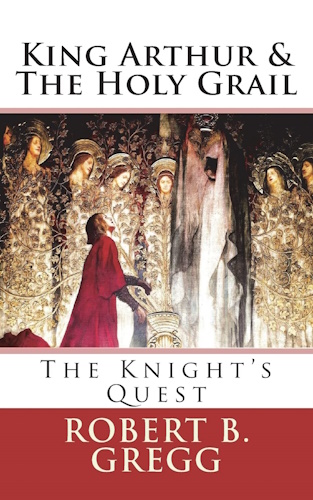

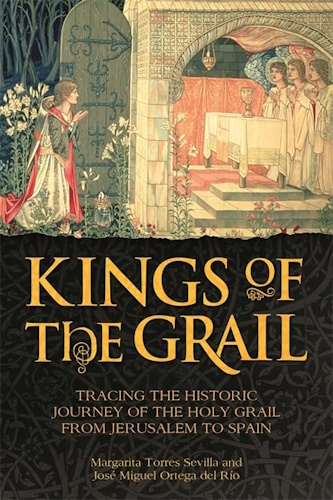

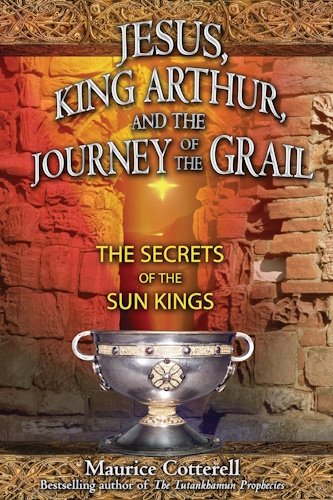



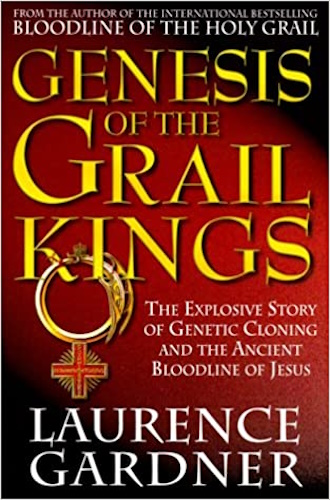

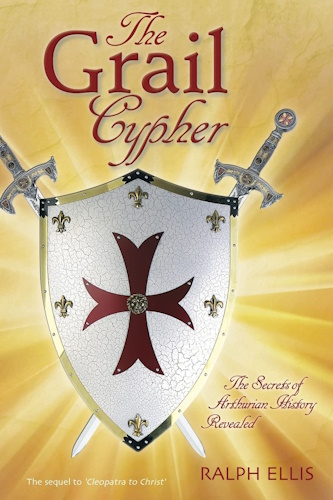

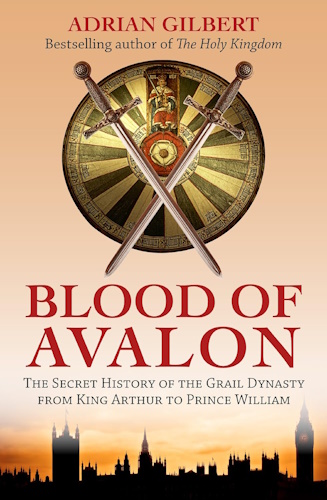

So who are the Rothschild's, and the Vatican system actually shielding? If we look closely at the Merovingian bloodline as it shows itself in Europe, we will get a better picture:
Pharamond
It all seems to begin with Pharamond.
409-426 AD
King Pharamond

Pharamond or Faramund is a legendary early king of the Franks first referred to in the anonymous 8th century Carolingian text Liber Historiae Francorum, also known as the Gesta regnum Francorum. In this work, which is customarily dated to 727, the anonymous author begins by writing of a mythical 'Trojan' origin for the Franks. The emphasis of the Liber was upon constructing a specific past for a particular group of people. This makes absolute sense because to study the Trojans one finds the exact mindset of the Nephilim or Black Nobility monarchs throughout history and in the present. The story is told of the election of the first Frankish king. It says that after the death of Sunno, his brother Marcomer, leader of the Ampsivarii and Chatti, proposed to the Franks that they should have one single king, contrary to their tradition. The Liber adds that Pharamond, named as Marchomir's son, was chosen as this first king thus beginning the tradition of long-haired kings of the Franks, and then states that when he died, his son Chlodio was raised up as the next king. The work says no more of him.
Because there is no reference in any source prior to this work to this figure named Pharamond, who is placed prior to Chlodio (that is, before 428 AD), scholars consider him a legendary rather than historical figure. In contrast to his depiction as a sole king, several sources, for example Gregory of Tours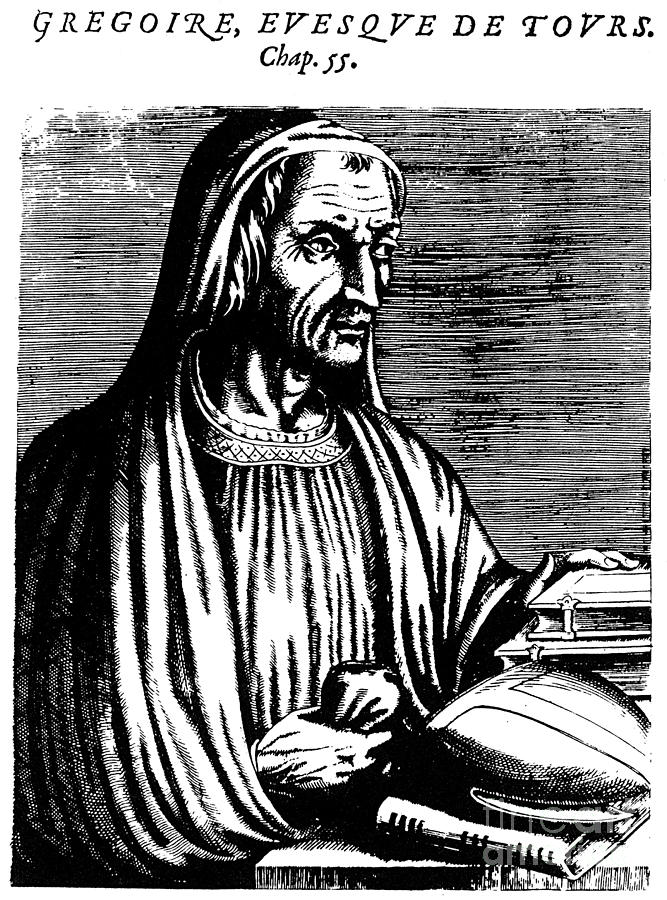 , attest multiple other rulers for his time (that is, before ca. 428). [It is thus a dubious matter to assume that, even had Pharamond existed, he was ever recognised as sole king.] The first king to unite all Franks was actually Clovis I. According to Rosamond McKitterick, the emphasis of the Liber was upon "construct[ing] a specific past for a particular group of people." [But after his death his empire was divided again amongst his sons who ruled again simultaneously. So we have the situation whereby forced onto a tribal community form of rule, we have the one king to rule them all scenario taking shape in France.]
, attest multiple other rulers for his time (that is, before ca. 428). [It is thus a dubious matter to assume that, even had Pharamond existed, he was ever recognised as sole king.] The first king to unite all Franks was actually Clovis I. According to Rosamond McKitterick, the emphasis of the Liber was upon "construct[ing] a specific past for a particular group of people." [But after his death his empire was divided again amongst his sons who ruled again simultaneously. So we have the situation whereby forced onto a tribal community form of rule, we have the one king to rule them all scenario taking shape in France.]
Next in line is the son of Pharamond:
Clodio, King of the Salian Franks
Born: ?
Died: 447
Father: Pharamond
Mother: ?
Married (1): ?
Children: Merovech King of The Salian Franks
King of the Salian Franks 426-447 AD

Of The Franks c.392-451
Again we have a semi-legendary King of the Salian Franks and father of Merovech, founder of the Merovingian Dynasty. Called, 'the Long Hair' or, 'the Hairy' because of the length of his hair. From then on the Merovingians were called the 'Long Haired Kings' and the cutting of a king's hair represented his loss of royal power. Just a little reminiscent of Samson?
According to legend his father was Pharamond 409-426, the first King of the Salian Franks after the departure of the Romans from Gaul. In history, Clodio can be proved real. He lived in Thuringian territory, and ruled at the same time as the semi-legendary kings Theudemer and Richemer. All that is known of his reign is that he took the town of Cambrai from the Romans. He was succeeded by his semi-legendary son Merovech. Although Merovech and Clodio are considered by some to be semi-legendary, Merovech's son, Childeric I, was very real and cannot be considered fictional.
Next in line we have:
Merovech, King of the Salian Franks
447-456 AD
Born: ?
Died: 456
Father: Clodio, King of the Salian Franks
Mother: ?
Married (1): ?
Children: Childeric I, king of the Salian franks

King of the Salian Franks 447-456
Semi-legendary early Frankish king for whom the Merovingian Dynasty is named Meroveus.
[That's it? That's all that is going to be said about the guy with whom the whole Merovingian dynasty, era, convolution and conspiracy originates??!!
I thought we'd at least hear Fredegar's legend that Merovech was conceived when Pharamond's wife encountered a Quinotaur while swimming. It wasn't stated, but it's implied that she was impregnated by it.
Okay, then...on we go.]
Next in line we have:
Childeric I, King of the Salian Franks
456-481 AD
Born: 437
Died: 481
Father:
Mother: ?
Married (1): Basina
Children: Clovis I, King of the Franks Audofleda Lanthechild
King of the Salian Franks 456-481

Childeric succeeded his semi-legendary father Merovech as king of the Salian Franks of northern Gaul in 456, during Roman times. He became infatuated with the daughters of his subjects, who were so incensed about this that they forced him to give up the throne. He discovered that they intended to assassinate him, and he fled to Thuringia, leaving a close friend and telling him to send him a message when Childeric could return to his kingdom.
Childeric took refuge with Bisinus, King of the Thuringian Franks, and his wife Basina. The king elected by the Franks was cruel, which made sure it was not long before Childeric was re-called to his kingdom by his friend, and was restored to the throne. Once Bisinus and Childeric were both kings, Basina deserted her husband and went to live with Childeric, who married her and had a son Clovis.
After a battle with Odoacer, King of the Saxons and conquerer of the Western Roman Empire, 476, at Orleans, Childeric and the Saxon king made a peace treaty and together subdued the Alamanni, who had invaded a part of Italy. In 481 Childeric died and was succeeded by Clovis, his son by Basina.
[I thought a map of Frankish power beginning with Clovis I would be helpful here. This is a really nice map and big enough (click on it) to read. Enjoy! ~GBA]

Next in line we have:
Clovis I, King of the Franks
481-511 AD
Born: 466
Died: 511
Father: Childeric I, King of the Salian Franks
Mother: Basina
Married (1): a concubine
Children: Theuderic I, King of Metz
Married (2): Saint Clotilda
Children: Ingomer, Chlodomer King of Orleans
Childebert I, King of Paris
Chlotar I, King of the Franks
Chrotilda King of the Salian Franks 481-486, King of the Franks 486-511
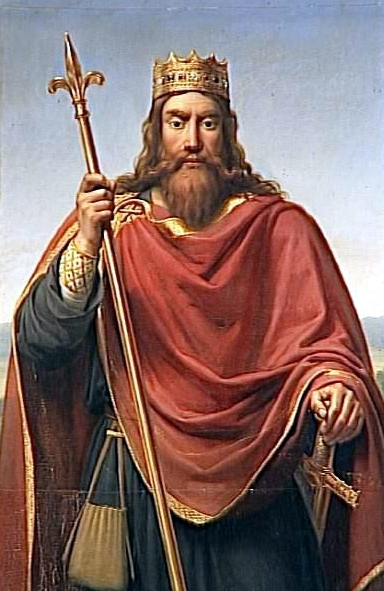
Clovis inherited his father's kingdom in 481, at which time he unified the Salian and Ripurian Franks. In 486 he defeated the Roman general Syagrius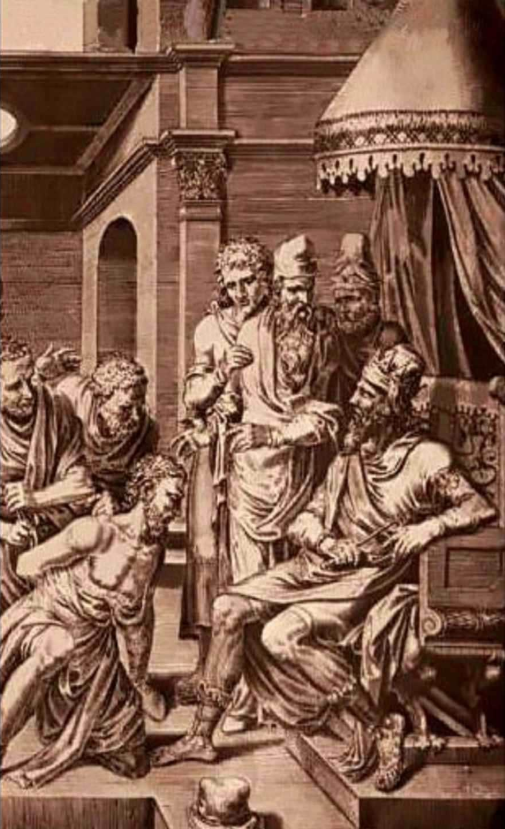 who ruled northern Gaul out of Soissons. By 493 he married the Burgundian princess Clotilda
who ruled northern Gaul out of Soissons. By 493 he married the Burgundian princess Clotilda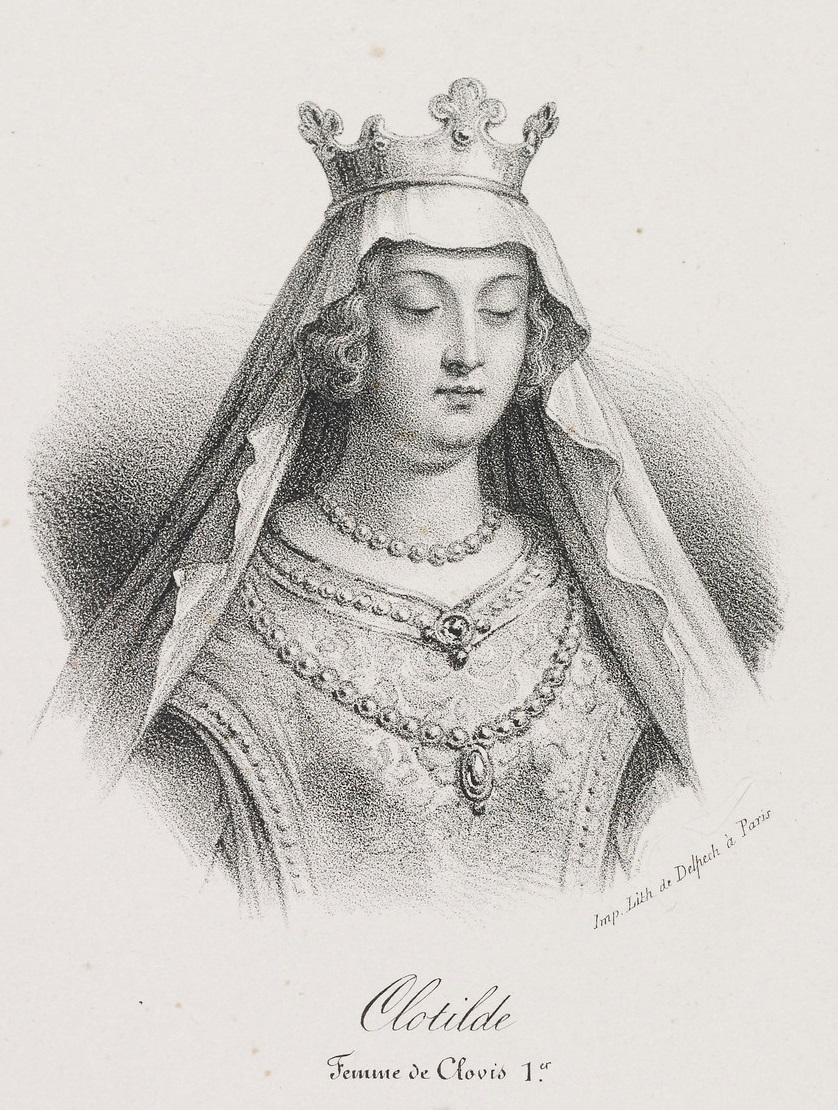 . In 496, after defeating the Alamanni, he was baptised, thus becoming the first Christian ruler of post-Roman Gaul. By 506 the Alamanni were subdued, and the next year Clovis finished his expansion by taking Aquitaine from the weak Visigothic king Alaric II. Clovis converted to Christianity in 496 so from this point we have the Christian Merovingians which is rather strange considering they are supposed to be the descendants of Jesus, did they forget for 496 years? On Clovis' death in 511, the kingdom was split between Chlodomer
. In 496, after defeating the Alamanni, he was baptised, thus becoming the first Christian ruler of post-Roman Gaul. By 506 the Alamanni were subdued, and the next year Clovis finished his expansion by taking Aquitaine from the weak Visigothic king Alaric II. Clovis converted to Christianity in 496 so from this point we have the Christian Merovingians which is rather strange considering they are supposed to be the descendants of Jesus, did they forget for 496 years? On Clovis' death in 511, the kingdom was split between Chlodomer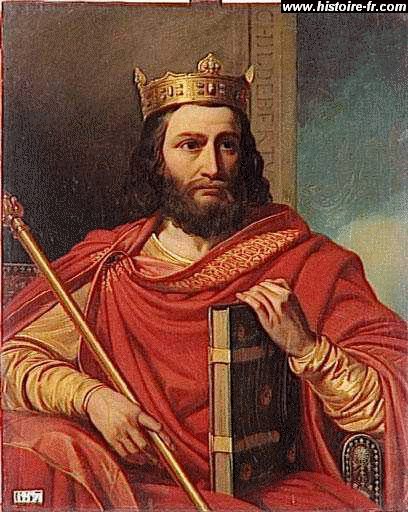 (Orleans), Childebert
(Orleans), Childebert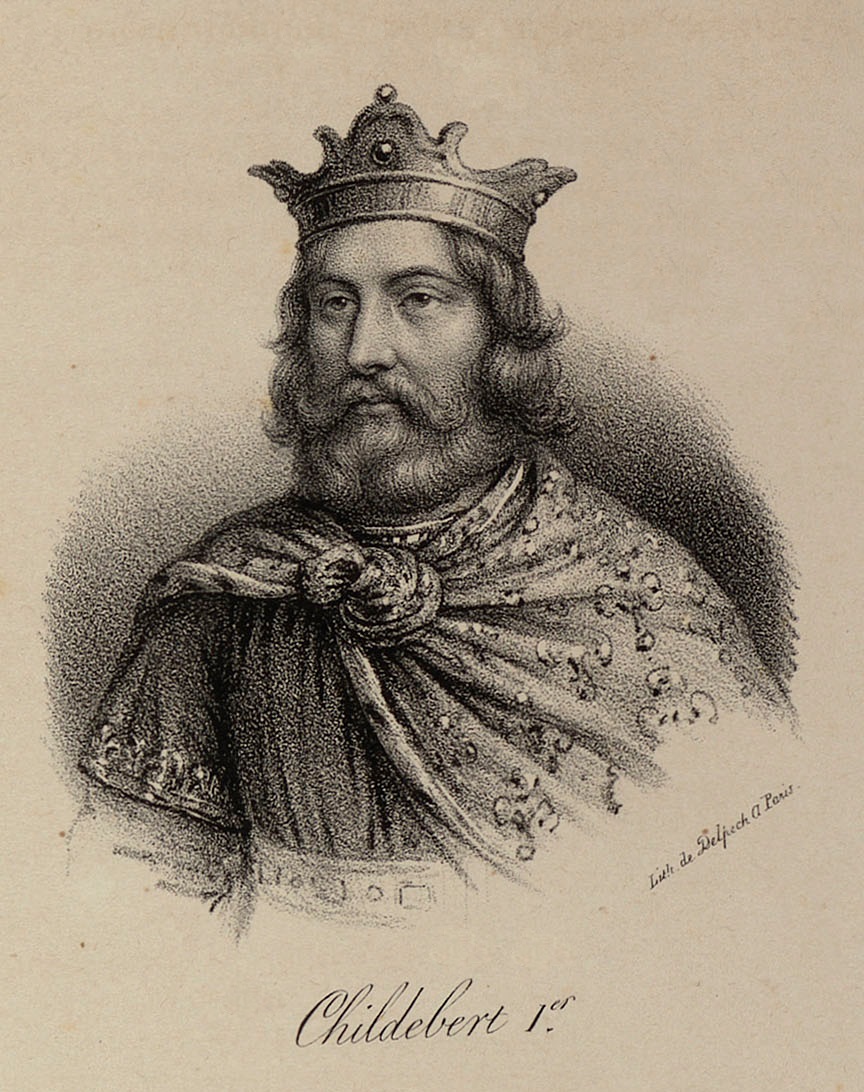 (Paris), Chlotar (Soissons), and Theuderic
(Paris), Chlotar (Soissons), and Theuderic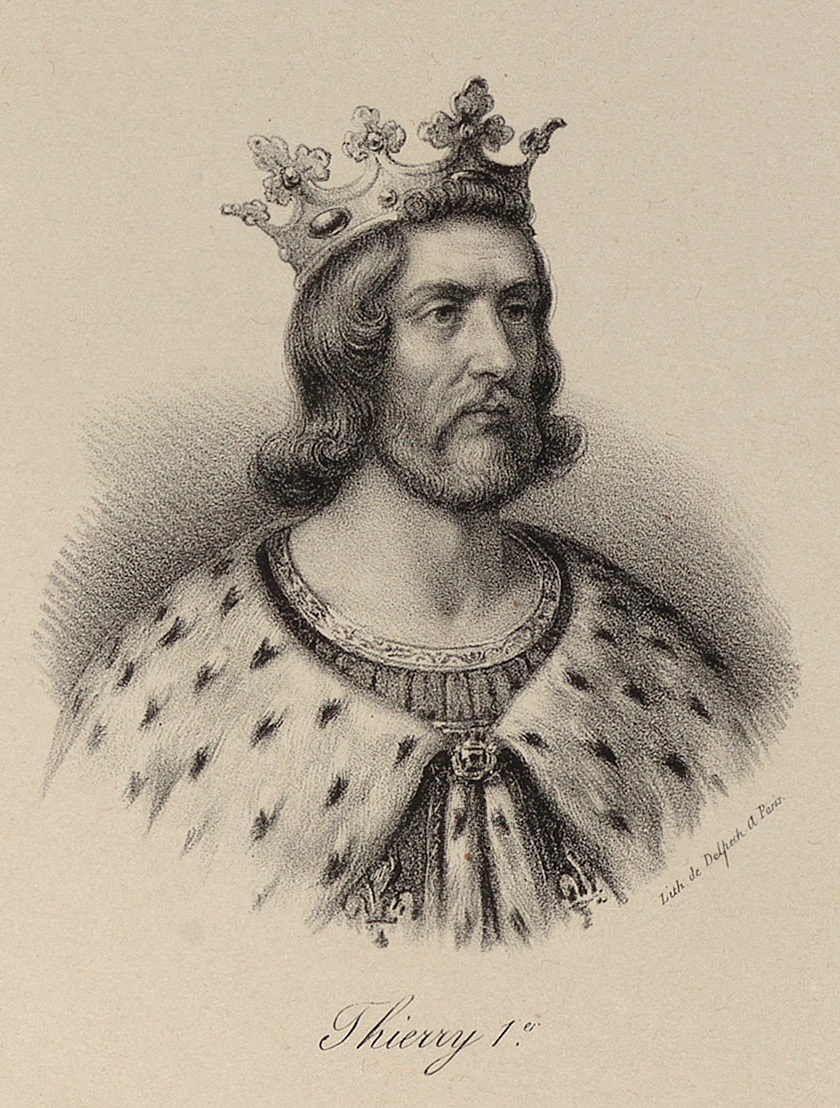 (Metz).
(Metz).
Next in line we have:
Chlotar King of the Franks
558-561 AD
King of Soissons 511-558
King of Austrasia 555-558
King of the Franks 558-561

Son of Clovis I, King of the Franks, he inherited Soissons on his death in 511. He, with his four brothers, attacked and defeated Burgundy under the kings Sigisbert and Godomar early in his reign. With his oldest brother Theuderic I, King of Metz, he attacked the Thuringian Franks under King Hermanfrid, took the kingdom, and took his daughter Radegund. Next, with his brother Childebert I, King of Paris, Chlotar murdered his nephews who were under the care of Queen Clotilda his mother. When Theuderic died, the kingdom was up for grabs. Chlotar and Childebert each received only a small part, the most of it going to Theudebert, his son. In 555, Theudebald, who had succeeded his father Theudebert in Austrasia, died, and Austrasia passed to Chlotar. When Childebert died in 558, Paris fell to Chlotar as well, thus making him sole ruler of the Franks. When Chlotar died in 561, the kingdom was divided among his 4 living sons: Charibert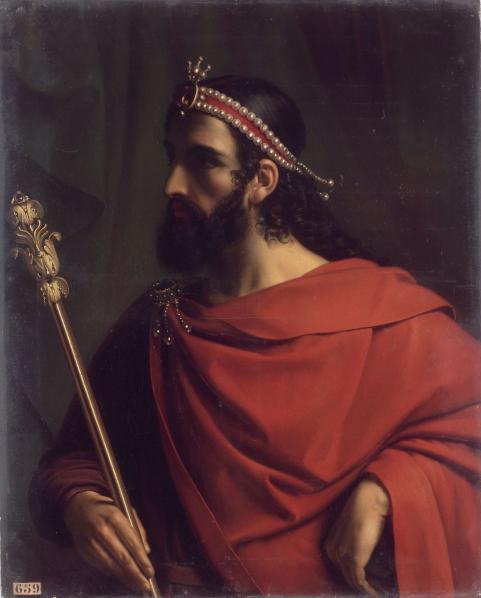 Paris, Guntram
Paris, Guntram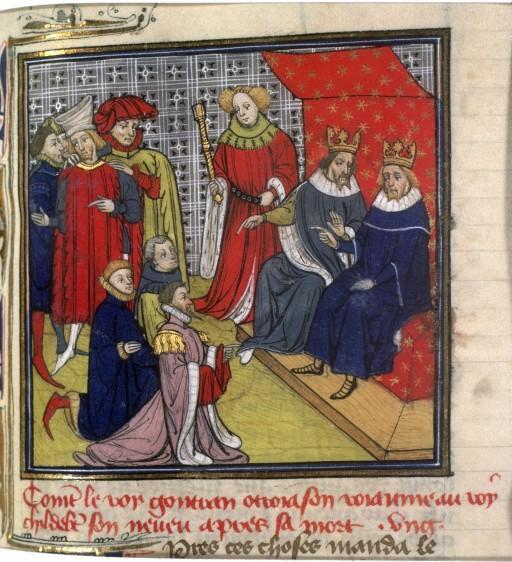 [Guntram left, Childerbert II right in the photo] Burgundy, Sigibert I
[Guntram left, Childerbert II right in the photo] Burgundy, Sigibert I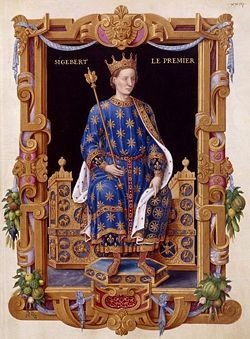 Austrasia, and Chilperic in Soissons
Austrasia, and Chilperic in Soissons
Next in line we have:
Chilperic I
561-584 AD
King of Soissons 561-584

When Chlotar, King of the Franks, died in 561 he divided the kingdom among his four sons: Chilperic received Soissons. Right away, in 562, Chilperic invaded the lands of his brother King Sigebert I of Metz, thus starting the civil wars. Sigebert advanced all the way to the city of Soissons, exiled Chilperic's son Theudebert, and forced a peace treaty out of Chilperic. In 567, their brother King Charibert I of Paris died, the kingdom was partitioned among the two and their other brother King Guntram of Burgundy, and Chilperic immediately invaded Sigebert's legal share, but was defeated.
Chilperic next allied with Guntram against Sigebert (who was in the midst of a war with Guntram). As hostilities mounted, Guntram switched his alliance to Sigebert and Chilperic surrendered. The same exact thing happened the next year, 575, when Guntram again allied with Chilperic. That year, Sigebert died and left his kingdom to his son Childebert II. Chilperic banished Sigebert's wife Brunhild, took her money, and imprisoned her daughters. Chilperic then renewed hostilities with Guntram. In that year, Guntram's general Mummolus defeated Duke Desidarius, Chilperic's senior general. In 577, Guntram and Childebert made an alliance, demanding all of the lands Chilperic took from them. When the dysentery epidemic swept through Gaul in 580, Chilperic not only lost two sons but became ill himself. However, by the next year he was doing better and was able to make peace with Childebert. That year, as Chilperic had no sons of his own, he named his nephew, King Childebert II of Austrasia, his successor. A war with Guntram began and ended this year in which Duke Desidarius took many cities from the kingdom of Burgundy. In 582, Chilperic and Fredegund had another son, Theuderic, who died two years later. In 584, Chilperic was assassinated. He died at peace with his brother Guntram and at war with his nephew and alleged successor Childebert, but left a son born that very year: Chlotar. So we can see that the Franks would once again be diss-united into their tribes, not until the arrival of Clotaire II (also named Lothair) would the tribes unite after great wars for supremacy in 613 AD.
Next in line we have:
Clotaire II also known as Lothair II
584-629 AD
Frankish king and son of Chilperic I and Fredegunde.

He succeeded in 584 taking over from his father as king of Neustria, but his mother ruled for him until her death in 597. In 613, after the death of his cousin Theodoric II, king of Austrasia, he was called in by Austrasian nobles to assume rule. He thus became king of all the Franks. He put Brunhilda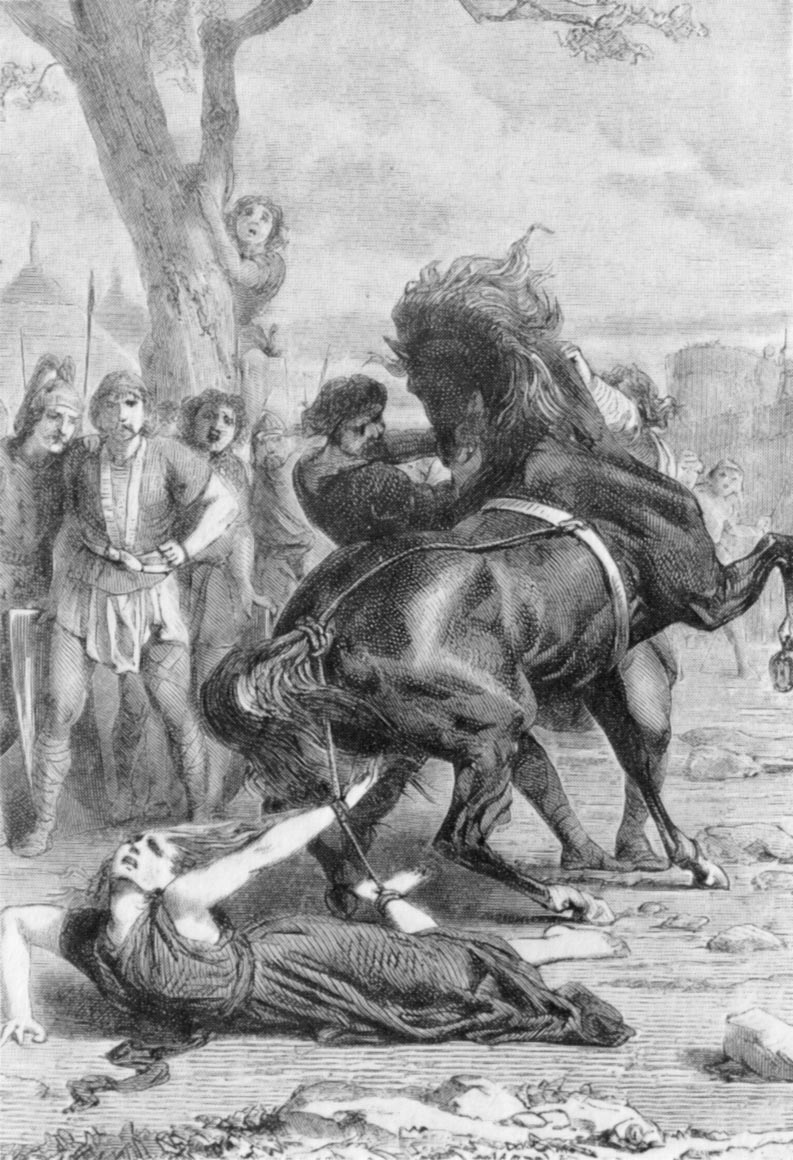 to death, restored peace with the help of the nobility, and was compelled to grant in 614, a charter giving far-reaching privileges to nobles and clergy. He was also forced to agree that each of the component parts of the Frankish lands, Austrasia, Neustria, and Burgundy, would have its own mayor of the palace; the mayors of the palace were the chief royal administrators. In 623 he sent his son Dagobart I to be king of Austrasia. Dagobert later succeeded to all the Frankish lands. What we can see clearly here is a major change in the way the Franks, now Merovingians; operate their system of control, giving power to the nobles and the Clergy. So from Clovis I Christianity is taken on by them with great military campaigns, [funny how Christianity and conquer have gone hand in hand], and from the death of Chilperic the Roman systems fuse with the Frankish system. So what goes on here?
to death, restored peace with the help of the nobility, and was compelled to grant in 614, a charter giving far-reaching privileges to nobles and clergy. He was also forced to agree that each of the component parts of the Frankish lands, Austrasia, Neustria, and Burgundy, would have its own mayor of the palace; the mayors of the palace were the chief royal administrators. In 623 he sent his son Dagobart I to be king of Austrasia. Dagobert later succeeded to all the Frankish lands. What we can see clearly here is a major change in the way the Franks, now Merovingians; operate their system of control, giving power to the nobles and the Clergy. So from Clovis I Christianity is taken on by them with great military campaigns, [funny how Christianity and conquer have gone hand in hand], and from the death of Chilperic the Roman systems fuse with the Frankish system. So what goes on here?
Next in line we have:
Dagobert I King of the Franks
623-639 AD
Born: 605 AD
Died: -639 AD
Father: Clotaire II (King of the Franks, d. 629)
Brother: Charibert (d. 632)
Nationality: Barbarian
Executive summary: King of the Franks, 629-39
Dagobert I, King of the Franks, was the son of Clotaire II.

In 623 his father established him as king of the region east of the Ardennes, and in 626 revived for him the ancient kingdom of Austrasia, minus Aquitaine and Provence. As Dagobert was yet but a child, he was placed under the authority of the mayor of the palace, Pippin, and Arnulf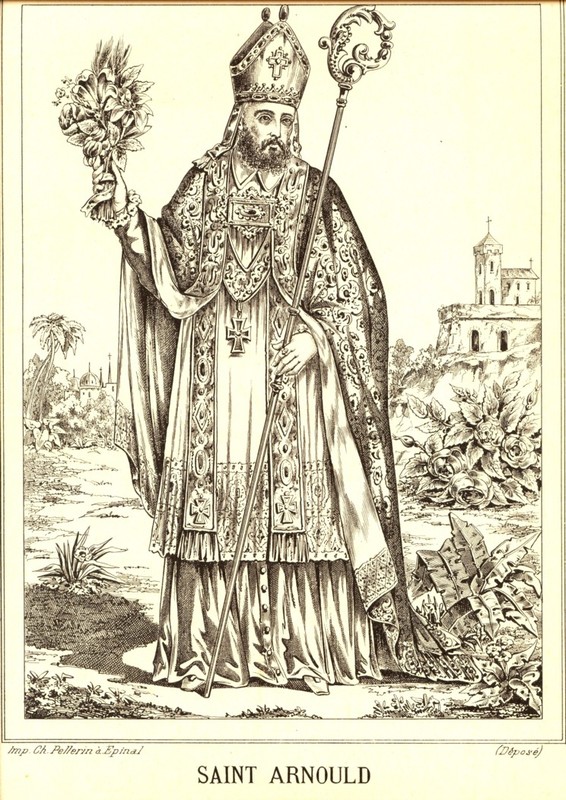 , bishop of Metz. At the death of Clotaire II in 629, Dagobert wished to re-establish unity in the Frankish realm and in 629 and 630 made expeditions into Neustria and Burgundy, where he succeeded in securing the recognition of his authority. In Aquitaine he gave his brother Charibert the administration of the counties of Toulouse, Cahors, Agen, Périgueux, and Saintes; but at Charibert's death in 632 Dagobert became sole ruler of the whole of the Frankish territories south of the Loire. Under him the Merovingian monarchy attained its culminating point. He restored to the royal domain the lands that had been usurped by the great nobles and by the church; he maintained at Paris a luxurious, though, from the example he himself set, a disorderly court; he was a patron of the arts, and delighted in the exquisite craftsmanship of his treasurer, the goldsmith St. Eloi
, bishop of Metz. At the death of Clotaire II in 629, Dagobert wished to re-establish unity in the Frankish realm and in 629 and 630 made expeditions into Neustria and Burgundy, where he succeeded in securing the recognition of his authority. In Aquitaine he gave his brother Charibert the administration of the counties of Toulouse, Cahors, Agen, Périgueux, and Saintes; but at Charibert's death in 632 Dagobert became sole ruler of the whole of the Frankish territories south of the Loire. Under him the Merovingian monarchy attained its culminating point. He restored to the royal domain the lands that had been usurped by the great nobles and by the church; he maintained at Paris a luxurious, though, from the example he himself set, a disorderly court; he was a patron of the arts, and delighted in the exquisite craftsmanship of his treasurer, the goldsmith St. Eloi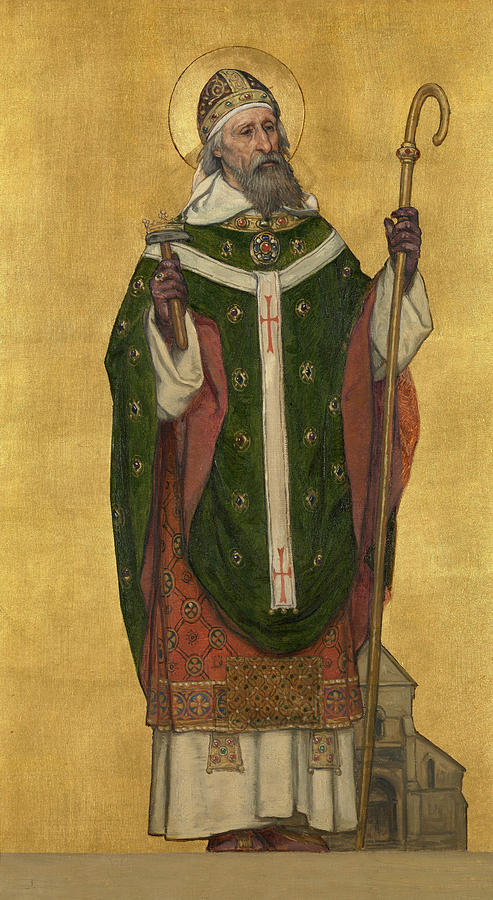 . His authority was recognised through the length and breadth of the realm. The duke of the Basques came to his court to swear fidelity, and at his villa at Clichy the chief of the Bretons of Domnoné promised obedience. He intervened in the affairs of the Visigoths of Spain and the Lombards of Italy, and was heard with deference. Indeed, as a sovereign, Dagobert was reckoned superior to the other barbarian kings. He entered into relations with the eastern empire, and swore a "perpetual peace" with the emperor Heraclius; and it is probable that the two sovereigns took common measures against the Slav and Bulgarian tribes, which ravaged in turn the Byzantine state and the German territories subject to the Franks. [At this point we can see the invasion of the Germanic tribes of the Khazars]. Dagobert protected the church and placed illustrious prelates at the head of the bishoprics -- Eloi (Eligius) at Noyon, Ouen (Audoenus)
. His authority was recognised through the length and breadth of the realm. The duke of the Basques came to his court to swear fidelity, and at his villa at Clichy the chief of the Bretons of Domnoné promised obedience. He intervened in the affairs of the Visigoths of Spain and the Lombards of Italy, and was heard with deference. Indeed, as a sovereign, Dagobert was reckoned superior to the other barbarian kings. He entered into relations with the eastern empire, and swore a "perpetual peace" with the emperor Heraclius; and it is probable that the two sovereigns took common measures against the Slav and Bulgarian tribes, which ravaged in turn the Byzantine state and the German territories subject to the Franks. [At this point we can see the invasion of the Germanic tribes of the Khazars]. Dagobert protected the church and placed illustrious prelates at the head of the bishoprics -- Eloi (Eligius) at Noyon, Ouen (Audoenus)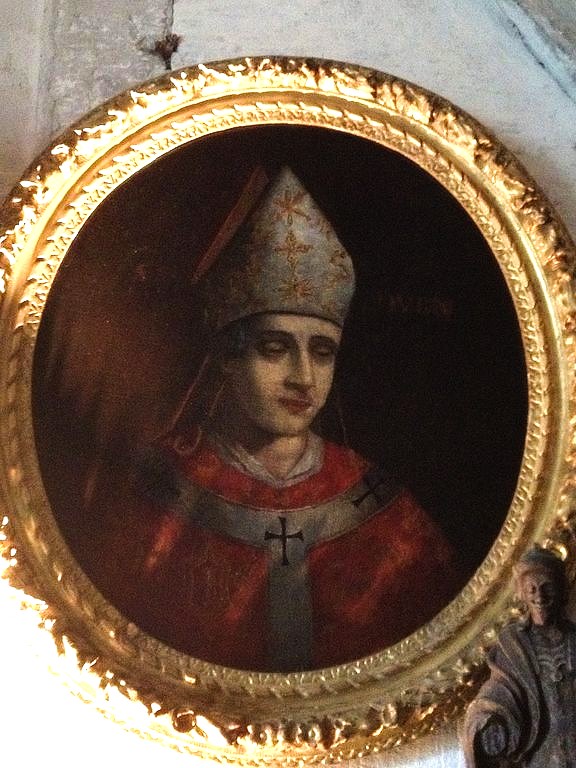 at Rouen, and Didier (Desiderius)
at Rouen, and Didier (Desiderius)![]() at Cahors. His reign is also marked by the creation of numerous monasteries and by renewed missionary activity, in Flanders and among the Basques. He died on the 19th of January 639, (I'll wager a bet he died on January 17th, the feast of St Sulpice, and is the real deity to which this day has special resonance with the esoteric aspect to the Vatican] and was buried at St. Denis. After his death the Frankish monarchy was again divided. In 634 he had been obliged to give the Austrasians a special king in the person of his eldest son Sigebert, and at the birth of a second son, Clovis, in 635, the Neustrians had immediately claimed him as king. Thus the unification of the realm, which Dagobert had re-established with so much trouble, was annulled.
at Cahors. His reign is also marked by the creation of numerous monasteries and by renewed missionary activity, in Flanders and among the Basques. He died on the 19th of January 639, (I'll wager a bet he died on January 17th, the feast of St Sulpice, and is the real deity to which this day has special resonance with the esoteric aspect to the Vatican] and was buried at St. Denis. After his death the Frankish monarchy was again divided. In 634 he had been obliged to give the Austrasians a special king in the person of his eldest son Sigebert, and at the birth of a second son, Clovis, in 635, the Neustrians had immediately claimed him as king. Thus the unification of the realm, which Dagobert had re-established with so much trouble, was annulled.
The kingdom was once again spread across differing kings with Dagobert's two sons Clovis II in Neustria and Burgandy from 639-657 and Sigebert III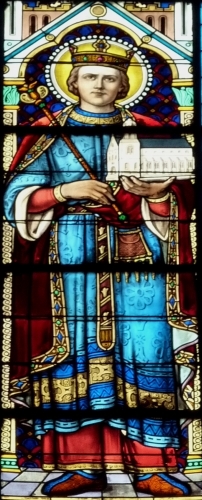 in Austrasia. Sigibert had been king in Austrasia from 632 while Dagobert was alive, and on his own from 639 after his father's death until 656. At the death of Sigibert his son Dagobert II
in Austrasia. Sigibert had been king in Austrasia from 632 while Dagobert was alive, and on his own from 639 after his father's death until 656. At the death of Sigibert his son Dagobert II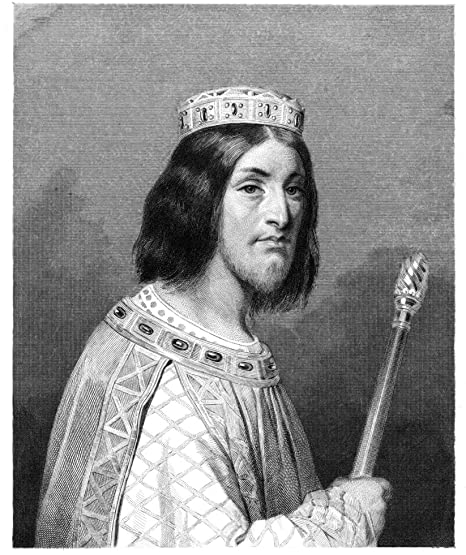 became king of Austrasia until either 660 or 661, ENTER THE USURPERS A SECOND TIME...and the point 'the Carolingians' took full control. Dagobert II regained the throne in 676 until he was assassinated in 679. Now this is a very interesting part in the history because it has direct links to the Rennes le Château mystery. This is the story of the blackmail by the Templars against the Roman Church in relation to their assassination of Dagobert II who it was claimed was a direct descendant of Jesus, thus the reason the priest who found the documents at the chateau became extremely wealthy and allowed to basically go as he pleased. So why did the Church believe they had killed a descendant of Christ when one can see from the history of the bloodline...this is nonsense? Whatever happened at this point, everything changed?
became king of Austrasia until either 660 or 661, ENTER THE USURPERS A SECOND TIME...and the point 'the Carolingians' took full control. Dagobert II regained the throne in 676 until he was assassinated in 679. Now this is a very interesting part in the history because it has direct links to the Rennes le Château mystery. This is the story of the blackmail by the Templars against the Roman Church in relation to their assassination of Dagobert II who it was claimed was a direct descendant of Jesus, thus the reason the priest who found the documents at the chateau became extremely wealthy and allowed to basically go as he pleased. So why did the Church believe they had killed a descendant of Christ when one can see from the history of the bloodline...this is nonsense? Whatever happened at this point, everything changed?
With the takeover of the Palace by the Carolingians the Merovingian kings became mere puppets, especially so with the next king:
Pepin of Herstal
687-715 AD

Sometimes called Carlovingian, second dynasty of Frankish kings. The family was descended from Pepin the Elder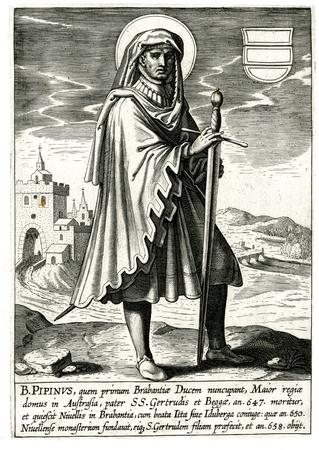 of Landen, a powerful landowner who served Clotaire II (c. 584–629), the Merovingian king of the Franks serving as mayor of the palace of Austrasia, the eastern part of the kingdom. Pepin's grandson, Pepin of Herstal, eventually succeeded to the mayor's position, and by 687 he had become the effective ruler of the entire Frankish kingdom, although the Merovingians nominally wielded the royal power. Pepin of Herstal was in turn succeeded by his illegitimate son, Charles Martel, and by two grandsons, Carloman
of Landen, a powerful landowner who served Clotaire II (c. 584–629), the Merovingian king of the Franks serving as mayor of the palace of Austrasia, the eastern part of the kingdom. Pepin's grandson, Pepin of Herstal, eventually succeeded to the mayor's position, and by 687 he had become the effective ruler of the entire Frankish kingdom, although the Merovingians nominally wielded the royal power. Pepin of Herstal was in turn succeeded by his illegitimate son, Charles Martel, and by two grandsons, Carloman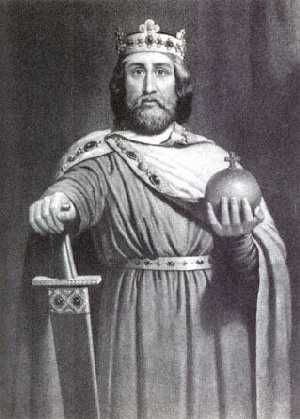 (c. 715–54) and Pepin the Short
(c. 715–54) and Pepin the Short . Carloman later abdicated, and in 751 Pepin the Short was crowned as the first Carolingian king of the Franks. This date is generally regarded as the beginning of the Carolingian dynasty. It is historically significant that Pepin was the first Frankish king whose coronation was sanctified by the church.
. Carloman later abdicated, and in 751 Pepin the Short was crowned as the first Carolingian king of the Franks. This date is generally regarded as the beginning of the Carolingian dynasty. It is historically significant that Pepin was the first Frankish king whose coronation was sanctified by the church.
Pepin was succeeded by his two sons Carloman (751–71) and Charlemagne, who at first ruled the kingdom jointly. After 771 Charlemagne was sole ruler and vastly increased the kingdom. At its greatest extent, it included what is now France, Germany, Austria, Switzerland, the Low Countries, and northern Italy. On Dec. 25, 800, Charlemagne was crowned the first emperor of the revived Western Roman Empire. The kingdom was inherited by Louis I ; upon his death, it was divided among his three surviving sons. The kingdom was disturbed by civil war rising from questions of inheritance, and in 843 it was formally divided by the treaty of Verdun. Thereafter the power of the dynasty further declined. The German line, which also ruled the Holy Roman Empire, became extinct in 911 and was replaced by the Saxons; the French line held power until 987, when it was succeeded by the Capetians. [We are talking black Nobility here]
; upon his death, it was divided among his three surviving sons. The kingdom was disturbed by civil war rising from questions of inheritance, and in 843 it was formally divided by the treaty of Verdun. Thereafter the power of the dynasty further declined. The German line, which also ruled the Holy Roman Empire, became extinct in 911 and was replaced by the Saxons; the French line held power until 987, when it was succeeded by the Capetians. [We are talking black Nobility here]
Next great man of this new dynasty, with no real trace of the original Gaulish bloodline, we have:
Charles Martel
Born: about 688
Died: at Quierzy on the Oise, 21 October, 741

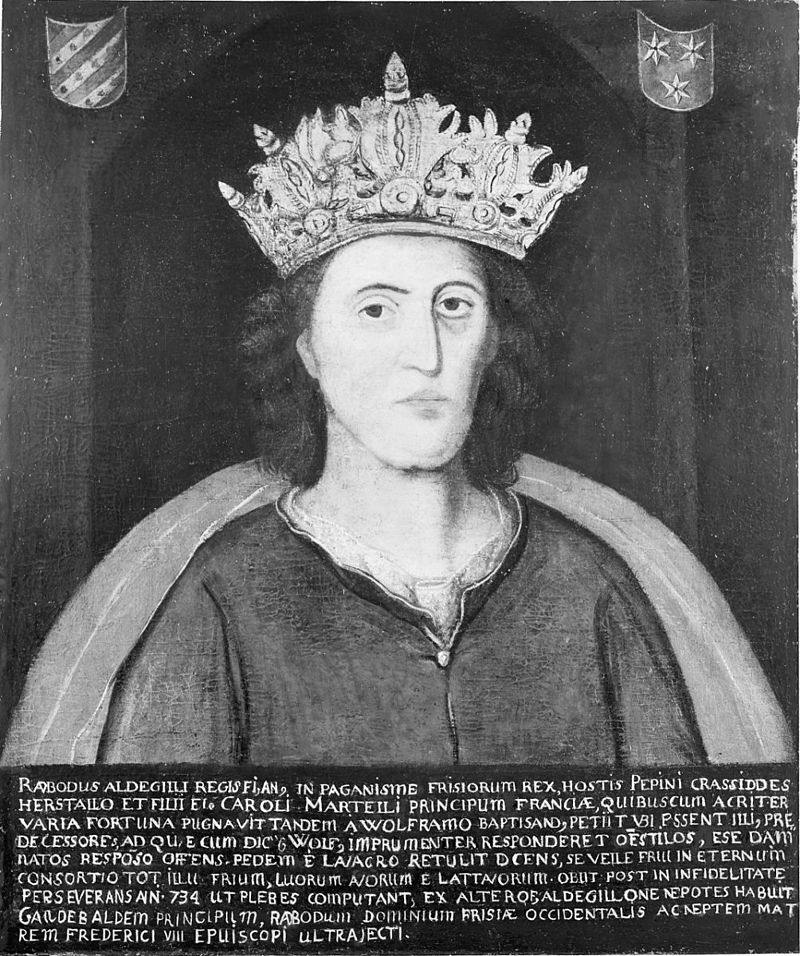 near Cologne in 716, and the Neustrians forced Plectrude to acknowledge as the king Chilperic, the son of Childeric II, having taken this Merovingian from the seclusion of the cloister, where he lived under the name of Daniel. (This rings so for the Crowned Prince Louis, son of Mary Antoinette who would take over American land and infrastructure as Daniel Payseur) But Charles was quick to take revenge. He surprised and conquered the Neustrians at Amblève near Malmédy in 716, then defeated them a second time at Vincy near Cambria on 21 March, 717, and pursued them as far as Paris. Then retracing his moves, he came to Cologne and compelled Plectrude to surrender her power and turn over the wealth of his father, Pepin. In order to give his recently acquired authority a touch of legitimacy, he proclaimed the Merovingian Clotaire IV King of Austrasia, ensuring for himself the title of Mayor of the Palace. It was about this time that Charles banished Rigobert, the Bishop of Reims, who had opposed him, appointing in his place the warlike and un-priestly Milon, who was already Archbishop of Trier.
near Cologne in 716, and the Neustrians forced Plectrude to acknowledge as the king Chilperic, the son of Childeric II, having taken this Merovingian from the seclusion of the cloister, where he lived under the name of Daniel. (This rings so for the Crowned Prince Louis, son of Mary Antoinette who would take over American land and infrastructure as Daniel Payseur) But Charles was quick to take revenge. He surprised and conquered the Neustrians at Amblève near Malmédy in 716, then defeated them a second time at Vincy near Cambria on 21 March, 717, and pursued them as far as Paris. Then retracing his moves, he came to Cologne and compelled Plectrude to surrender her power and turn over the wealth of his father, Pepin. In order to give his recently acquired authority a touch of legitimacy, he proclaimed the Merovingian Clotaire IV King of Austrasia, ensuring for himself the title of Mayor of the Palace. It was about this time that Charles banished Rigobert, the Bishop of Reims, who had opposed him, appointing in his place the warlike and un-priestly Milon, who was already Archbishop of Trier.
The ensuing years were full of problems. Eager to punish and express his might to the Saxons who had invaded Austrasia, Charles in 718 laid waste to their country to the banks of the Weser. In 719 Radbod died, and Charles seized Western Friesland without any great resistance on the part of the Frisians, who had taken possession of it on the death of Pepin. The Neustrians, always a problem, had joined forces with the people of Aquitaine, but Charles decimated their army at Soissons. After this defeat they realised the necessity of surrendering, and the death of King Clotaire IV, whom Charles had placed on the throne two years earlier, facilitated reconciliation of the two great factions of the Frankish Empire. Charles acknowledged Chilperic as head of the entire monarchy, while on their side, the Neustrians and Aquitainians endorsed the authority of Charles; but, when Chilperic died in the following year 720 Charles appointed as his successor the son of Dagobert III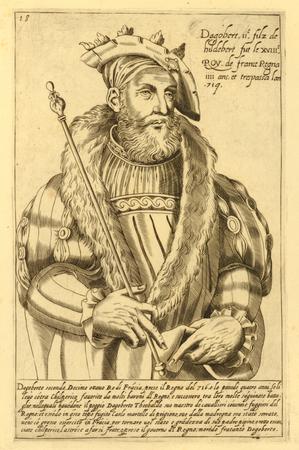 , Thierry IV, who was still a child, and who occupied the throne from 720 to 737.
, Thierry IV, who was still a child, and who occupied the throne from 720 to 737.
A second expedition against the Saxons in 720 and the definitive submission of Raginfrid, who had been left the county of Angers in 724, re-established the Frankish / Carolingian Monarchy as it had been under Pepin of Herstal, and closed the first series of Charles Martel's major problems. The next six years were devoted almost exclusively to the confirming of the Frankish authority over the dependent Germanic tribes, so the Germanic tribes were attacked on both sides, by the new Christian Gauls and the Eastern Hun originating warlords. In 725 and 728 Charles went into Bavaria, where the Agilolfing dukes had gradually positioned themselves independent, and re-established Frankish command. He also brought Princess Suanehilde, who it would seem became his mistress. In 730 he marched against Lantfrid, Duke of the Alemanna, whom he also brought into subjection, and thus Southern Germany once more became part of the Frankish Empire, as had Northern Germany during the first years of the reign. Everything would change however because at the edge of the empire an extremely unwanted race was spoiling for expansion of their lands... For several years the Moslems of Spain had been threatening Gaul. Having been removed in 721 by Duke Eudes, they had returned in 725 and penetrated as far as Burgundy, where they destroyed Autun. Duke Eudes, unable to stop them, had made use of an old trick and made his play by negotiating with them, and to Othmar, one of their chiefs, he gave the hand of his daughter But this compromising alliance brought him the wrath of Charles, who defeated him in 731, and the death of Othmar that same year would again leave Eudes at the mercy of Moslem covetousness. In 732 Abd-er-Rahman, Governor of Spain, crossed the Pyrenees at the head of a massive army, overcame Duke Eudes, and advanced as far as the Loire, burning and pillaging as he went. In October, 732, Charles met Abd-er-Rahman outside of Tours and defeated his army and killed him in the Battle of Poitiers which remains one of the great events in the history of the world, as upon its outcome depended whether Christian Civilisation should continue or Islam prevail throughout Europe. It was this battle, it is said, that gave Charles his name, Martel (Tudites) 'The Hammer, because of the merciless way in which he destroyed the enemy. This show of might from a Christian king was the main reason the Khazars would convert to Judaism a few years later so as not to be absorbed by the Moslems to the south and East, and by the Christians to the West. So this is a very important time in European history.
The remainder of Charles Martel's reign was an uninterrupted series of victories. In 733-734 he defeated the rebellion instigated by the Frisian duke, Bobo, who was killed in battle, and definitively subdued Friesland, which finally adopted Christianity. In 735, after the death of Eudes, Charles entered Aquitaine, demolished the revolt of Hatto and Hunold, sons of the deceased duke, and left the duchy to Hunold, to be held in fief in the year 736. He then removed the Moslems from Arles and Avignon, defeated their army on the River Berre near Narbonne, and in 739 destroyed an uprising in Provence, the rebels under the leadership of Maurontus.
So great was Charles' power during the last years of his reign that he did not appoint a successor to King Thierry IV, who died in 737, and assumed full authority himself, governing without the legal right. Around a year before Charles died, Pope Gregory III, threatened by Luitprand, King of Lombardy asked his help. Now Charles was Luitprand's ally because the latter had promised to assist him in the late war against the Moslems of Provence, and, moreover, the Frankish king may have already suffered from the malady that was to carry him off...two reasons that are surely reasons enough to account for the fact that the Pope's envoys departed without gaining the object of their mission. However, according to the terms of a public act published by Charlemagne, Charles had, at least in principle, agreed to defend the Roman Church, this helped to enshrine the Christian Carolingians parading as the Merovingian Franks, and that death alone had prevented him from fulfilling this agreement. But then Charlemagne would wouldn't he? His reign, which in the beginning was so full of bloody conflicts and later of such persistent troubles, would have been imposable had not Charles procured means sufficient to attract and compensate his allies. For this purpose he conceived the idea of giving them the usufruct of a great many ecclesiastical lands, and this adventure is what is referred to as the secularisation by Charles Martel.
It was an expedient that could be excused without, however, being justified, and it was his redeeming facto cast in stone by the amnesty granted at the Council of Lestines, held under the sons of Charles Martel in 743. This is also the reason he is exonerated for his actions by all who study this mans life and held in good regard. It must also be remembered that the Church remained the legal [not lawful] owner of the lands thus stolen, but as history tells us...the Church has always been the puppet of the Imperial Nephilim bloodline families under Constantine, made so undoubtedly by the next man to take the reigns of power after Charles Martel. This turbulence and the conferring of the principal ecclesiastical dignities upon those who were either totally unworthy or else had naught but their military qualifications to recommend them...as, for instance, the assignment of the episcopal Sees of Reims and Trier to Milon...were not calculated to endear Charles Martel to the clergy of this time.
Therefore, in the ninth century Hincmar of Reims related the story of the vision with which St. Eucher was said to have been favoured and which showed Charles in hell, to which he had been condemned for robbing the Church of its property. [Funny this, in that this Church has stolen everything it owns, and thus anything this Church claims as its opposite is my heaven. Thus covering the facts that just such inappropriate persons would continue to ease themselves into the root and branch of the Roman Church right up to today, Joseph Ratzinger the ex SS officer being prime example...] He died in 741 AD after having divided the Frankish Empire, as a patrimony between his two sons, Carloman and Pepin.
The next great leader in the story of the Merovingians who are not the Merovingian's at this point in time, but the 'Carolingians', and the hero and base root confluence of DNA to all current European monarchs and their administrators such as the Rockefellers, Bush's and Clinton etc...is:
Charlemagne
(French for Carolus Magnus, or Carlus Magnus ('Charles the Great); German Karl der Grosse)
Born: 2 April, 742
Died: at Aachen, 28 January, 814
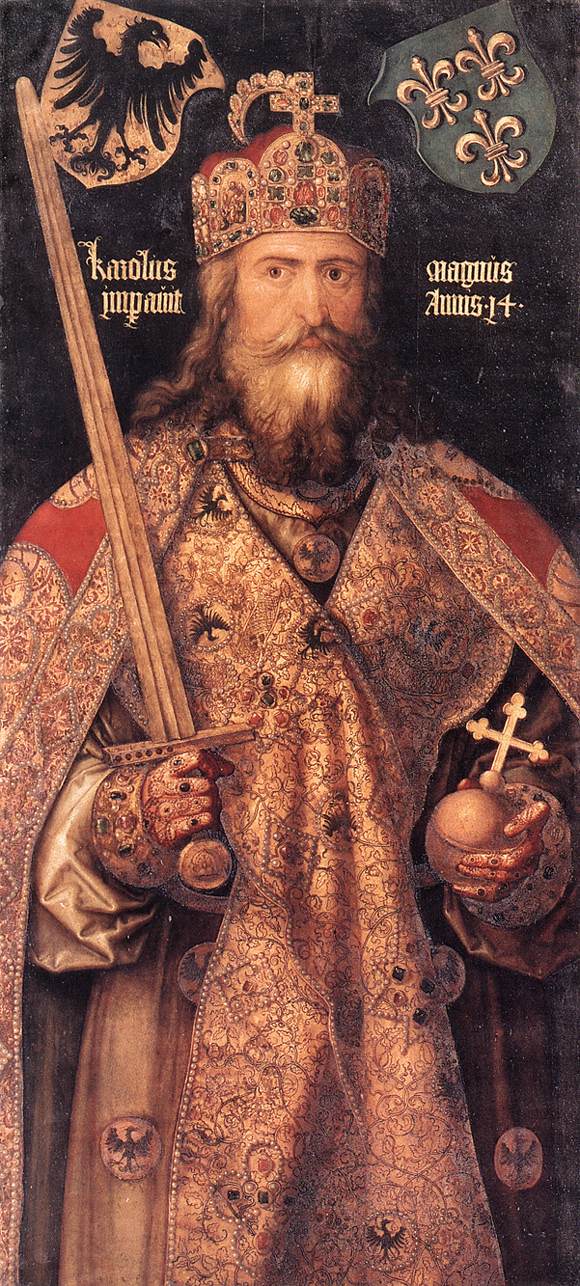
The name given to Charles, King of the Franks, first sovereign of the Christian Empire of the West; was Charlemagne. It is to be noted, however, that the place of his birth whether Aachen or Liege has never been fully and conclusively released, which throws suspicion as to his true pedigree as presented, also the traditional date has been set one or more years later by recent writers. If Alcuin is to be interpreted literally the year should be 745. At the time of Charles' birth, his father, Pepin the Short, Mayor of the Palace, of the line of Arnulf, was, theoretically, only the first subject of Childeric III, the last Merovingian King of the Franks; but this title implied that real power, military, civil, and even ecclesiastical, of which Childeric's crown was only the symbol. When such mystery surrounds such men one is always compelled to see Hybrid as the real genealogy, not only based on such mysterious births but especially so in relation to his actual status among the Nephilim of history and through to today, and indicates a child from the underground Elohim. Added to this evidence would be the fact it is not certain that Bertrada (or Bertha), the mother of Charlemagne, and daughter of Charibert, Count of Laon, was legally married to Pepin until some years later than either 742 or 745. What is for certain is the fact that from such mysterious births, we get the term, 'bastard', a very derogatory term in those days, and perhaps with good reason for it symbolises the hybrid Nefilim.
To the Fall of Pavia (742-774)
In 752, when Charles was a child of around ten years, Pepin the Short had appealed to Pope Zachary to recognise his actual rule with the kingly title and dignity. The practical effect of this appeal to the Holy See was the journey of Stephen III across the Alps around two years later, for the purpose of anointing with the oil of kingship not only Pepin, but also his son Charles and a younger son, Carloman. The Pope then lay upon the Christian Franks [Carolingians] a precept, under the gravest spiritual penalties, never "to choose their kings from any other family." Primogeniture [system of eldest son inheriting all] did not exist in the Frankish law of succession; the monarchy was elective, though eligibility was limited to the male members of the one privileged [or top] family. Thus, then, at St. Denis on the Seine, in the Kingdom of Neustria, on the 28th of July, 754, the house of Arnulf was by a solemn act of the supreme pontiff, established upon the throne until then occupied by the house of Merowig (Merovingians).
Charles, anointed to the kingly office while a mere child, learned the rudiments of war while still only a child, accompanying his father in several campaigns. This early experience is worth noting chiefly because it developed in the boy the military virtues [prowess] which, joined with his extraordinary physical strength and intense nationalism, made him a popular hero of the Franks long before he became their rightful ruler. [So if ever there was a classic case of absolute conditioning to play a role planned before his time...this is it.] At length, in September, 768, Pepin the Short, foreseeing his end, divided his dominions between his two sons. Not many days later the king passed away. [Not only that, all historical accounts proves the Nephilim to have far greater strength than the mass of people, usually down to their size. So wherever Charles came from, it was not from the ranks of the people.]
To better understand the effect of the act of partition under which Charles and Carloman inherited their father's dominions, as well as the whole subsequent history of Charles' reign, it is to be observed that those dominions comprised:
- First, Frankland (Frankreich) proper;
- Secondly, there were seven more self governing dependencies, peopled by races of various origins and operating under various codes of law
Of these two divisions, the former extended, roughly speaking, from the boundaries of Thuringia, on the east, to what is now the Belgian and Norman coastline, on the west; bordering to the north on Saxony, and included both banks of the Rhine from Cologne (the ancient Colonia Agrippina) to the North Sea; the southern borders backed on to the Bavarians, the Alemanni, and the Burgundians.
[In 1124 AD from the most famous Scottish Bloodlines of history leave northern France and Belgium to make home in Scotland. So not so Scottish at all eh! This happened during the reign of the Scottish Kings David 1 and Malcolm IV between 1124 and 1165. these were classic Scottish names like: Stewart, Seton, Hamilton, Campbell, Douglas, Montgomery, Balliol, Graham, Lindsay, CAMERON and Comyn, all arriving from Northern France and Belgium during this brief time. Please understand I am not saying if you have one of these names you are bad, , but in following the bloodlines it is essential information. It goes without saying they took over Scotland very quickly indeed. Of course this was made possible with the work of the Sinclair family.]
The dependent states were: Gaulish Neustria including Paris, well populated with a dominant Frankish element; to the southwest of Neustria was Brittany, formerly Armorica, [one can better understand who named America] with a British and Gallo-Roman population; to the south of Neustria the Duchy of Aquitaine, lying, for the most part, between the Loire and the Garonne, with a decidedly Gallo-Roman population; and east of Aquitaine, along the valley of the Rhone, the Burgundians, a people of much the same mixed origin as those of Aquitaine, though with a large infusion of Teutonic blood. [We are dealing here with the remnants of the migrating Egyptians from the time of Scotia, (See EGYPT page). Thus Charlemagne was the hybrid creature ordained to destroy and takeover these peoples for the Roman bloodlines. This is why Northern Britain and Southern Ireland have such an historical link to these areas, which would finally be decimated under the wars between the English hybrid kings with all the future wars between Britain and France.] These States, with perhaps the exception of Brittany, recognised the Theodosian Code as their law. The German dependencies of the Frankish kingdom were Thuringia, in the valley of the Main, Bavaria, and Alemannia (corresponding to what was later known as Swabia). These last, at the time of Pepin's death, had but recently been won to Christianity [the Roman Idea of Christianity], mainly through the preaching of St. Boniface. The share which fell to Charles consisted of all Austrasia (the original Frankland ), most of Neustria, and all of Aquitaine except the southeast corner. In this way the fiefdom of the elder brother surrounded the younger on two sides, but on the other hand the distribution of races under their respective rules was such as to preclude any risk of discord arising out of the national sentiments of their various subjects.
In spite of this provident [well portioned] arrangement, Carloman contrived to quarrel with his brother. Hunald, the former Duke of Aquitaine, vanquished by Pepin the Short, broke from the cloister, where he had lived as a monk for twenty years, and stirred up a revolt in the western part of the duchy. By Frankish custom Carloman should have aided Charles; the younger brother himself held part of Aquitaine; but he pretended that, as his dominion were unaffected by this revolt, it was no business of his. Hunald, however, was vanquished by Charles single-handed; he was betrayed by a nephew with whom he had sought refuge, was sent to Rome to answer for the violation of his monastic vows, and at last, after once more breaking cloister, was stoned to death by the Lombards of Pavia. For Charles the true importance of this Aquitanian episode was in its manifestation his brother's unkindly feeling in his regard, and against this danger he lost no time in taking precautions, chiefly by winning over to himself the friends whom he judged likely to be most valuable; first and foremost of these was his mother, Bertha, who had striven both earnestly and prudently to make peace between her sons, but who, when it became necessary to take sides with one or the other could not hesitate in her devotion to the elder. Charles was an affectionate son; it also appears that he was helped to power by his power of personal attractiveness.
Carloman died soon after this on 4 December, 771, and a certain letter from 'the Monk Cathwulph, quoted by Bouquet (Recueil. hist., V, 634), in enumerating the special blessings for which the king was in duty bound to be grateful, says:
Third . . . God has preserved you from the wiles of your brother . . . . Fifth, and not the least, that God has removed your brother from this Earthly kingdom.
Carloman may not have been quite as malignant as the partisans of Charles made him out, [which personifies the fact that Charles was the chosen hybrid to form the future of the Roman Church and Christendom] but the division of Pepin's dominions was in itself an impediment to the growth of a strong Frankish realm such as Charles needed for the unification of the Christian Continent. Although Carloman had two sons by his wife, Gerberga, the Frankish law of inheritance gave no preference to sons as against brother; left to their own choice, the Frankish lieges, whether from love of Charles or for the fear which his name already inspired, gladly accepted him for their king. [So we can see the original kings of France had nothing in common with the Nephilim bloodlines that would spawn from the hybrid Charlemagne.] Gerberga and her children fled to the Lombard court of Pavia. Mean while complications had arisen in Charles' foreign policy which made his newly established supremacy at home doubly opportune.
From his father [Pepin] Charles had inherited the title 'Patricius Romanus' which carried with it a special obligation to protect the material rights of the Holy See. The nearest and most menacing neighbour of St. Peter's Patrimony was Desidarius (Didier), King of the Lombards, and it was with this potentate that the dowager Bertha had arranged a matrimonial alliance for her elder son [Charles]. The Pope had solid material reasons for objecting to this arrangement. Moreover, Charles was already, in foro conscientiae, if not in Frankish law, married to Himiltrude. In defiance of the Pope's protest, Charles married Desiderata, daughter of Desiderius in 770, three years later he repudiated her and married Hildegarde, the beautiful Swabian. Naturally, Desiderius was furious at this insult, and the dominions of the Holy See bore the first brunt of his anger.
But Charles had to defend his own borders against the heathen [none [?? non possibly? ~GBA] Roman- Christians] as well as protecting Rome against the Lombards. To the north of Austrasia was Frisia, which seems to have been in some equivocal way a dependency, and to the east of Frisia, from the left bank of the Ems (about the present Holland - Westphalia frontier), across the valley of the Weser and Aller, and still eastward to the left bank of the Elbe, extended the country of the Saxons, who in no fashion whatever acknowledged any allegiance to the Frankish [Carolingian] kings.
In 772 these Saxons were a horde of aggressive pagans [society of none Roman Christians] offering to Christian missionaries no hope but that of martyrdom; bound together, normally, by no political organization, and constantly engaged in predatory incursions into the lands of the Franks [as individual communities within a chieftain society, the chief or king only took control in a state of war, the well respected Swedish model of community which was a respected and far more balanced form of co-existing without the need for centralisation of power the Nephilim hybrids covet, to the point they will murder all who oppose them...just look at Iraq, Sadam would not buy the American debt and placed the Sumer tablets on show for the world to study]. Their language seems to have been very like that spoken by the Egberts and Ethelreds of Britain, but the work of their [hybrid] Christian cousin, St. Boniface, had not affected them as yet [that would be for the Vikings to force]; they worshiped the gods of Walhalla, united in solemn sacrifice -- sometimes human -- to Irminsul (Igdrasail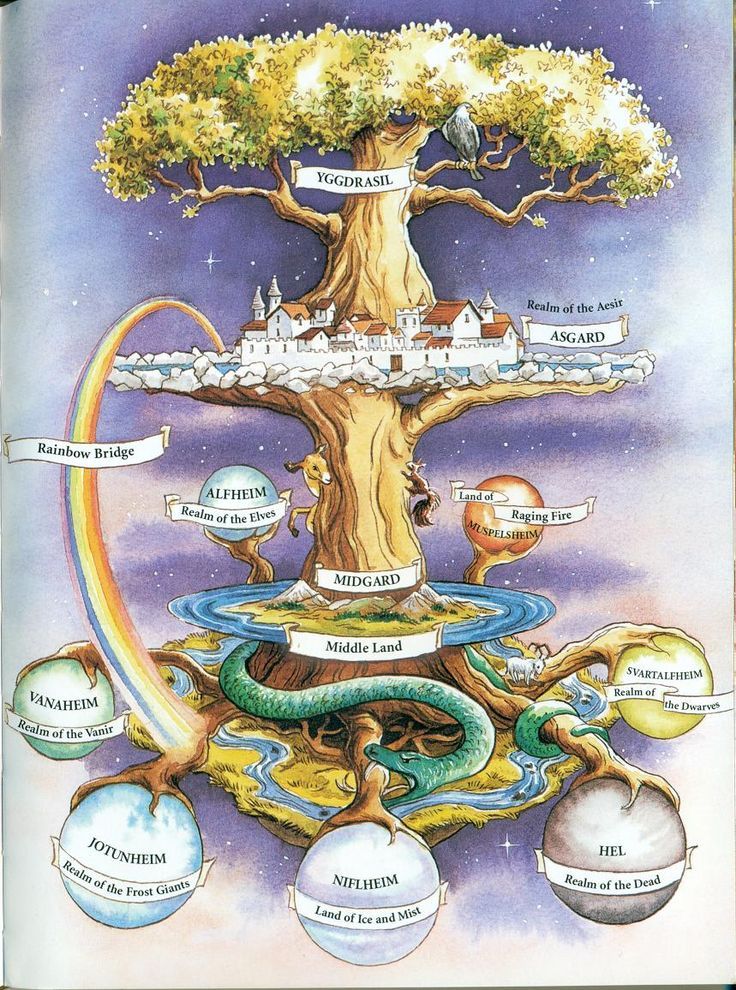 ), the sacred tree which stood at Eresburg, and were still slaying Christian missionaries while their [overrun] kinsmen in Britain were holding church synods and building cathedrals. Charles could brook neither their predatory habits nor their heathenish intolerance; it was impossible, moreover, to make permanent peace with them while they followed the old Teutonic life of free village communities [which is code for not doing as he tells them, they had to be invaded]. [It is there to be seen if one sees with ones own mind and not follow the blind so-called expert's 'Official Story' as to how we should perceive history. Aggression and the need for control is the only trait of all these supposed, 'heroes of history', they are in truth only the hero's for those who have this inbred need to dominate and control.] He made his first expedition into their country in July, 772, took Eresburg by storm, and burned Irminsul. [What a lovely Jesus type creature old Charlemagne was, Constantine would have been proud.] It was in January of this same year that Pope Stephen III died, and Adrian I, an opponent of Desiderius, was elected. The new pope was almost immediately assailed by the Lombard king, who seized three minor cities of the Patrimony of St. Peter, threatened Ravenna itself, and set about organizing a plot within the Curia. Paul Afiarta, the papal chamberlain, detected acting as the Lombard's secret agent, was seized and put to death [yet another show of the Church of Peter's Jesusness? What Bollocks]. The Lombard army advanced against Rome, but quailed before the spiritual weapons of the Church [this of course is Black Magic], while Adrian sent a legate into Gaul to claim the aid of the Patrician. [The Church of Peter's spiritual weapons would be the underground Elohim sent there after the routing of St George of Queen El and the serpent cult.]
), the sacred tree which stood at Eresburg, and were still slaying Christian missionaries while their [overrun] kinsmen in Britain were holding church synods and building cathedrals. Charles could brook neither their predatory habits nor their heathenish intolerance; it was impossible, moreover, to make permanent peace with them while they followed the old Teutonic life of free village communities [which is code for not doing as he tells them, they had to be invaded]. [It is there to be seen if one sees with ones own mind and not follow the blind so-called expert's 'Official Story' as to how we should perceive history. Aggression and the need for control is the only trait of all these supposed, 'heroes of history', they are in truth only the hero's for those who have this inbred need to dominate and control.] He made his first expedition into their country in July, 772, took Eresburg by storm, and burned Irminsul. [What a lovely Jesus type creature old Charlemagne was, Constantine would have been proud.] It was in January of this same year that Pope Stephen III died, and Adrian I, an opponent of Desiderius, was elected. The new pope was almost immediately assailed by the Lombard king, who seized three minor cities of the Patrimony of St. Peter, threatened Ravenna itself, and set about organizing a plot within the Curia. Paul Afiarta, the papal chamberlain, detected acting as the Lombard's secret agent, was seized and put to death [yet another show of the Church of Peter's Jesusness? What Bollocks]. The Lombard army advanced against Rome, but quailed before the spiritual weapons of the Church [this of course is Black Magic], while Adrian sent a legate into Gaul to claim the aid of the Patrician. [The Church of Peter's spiritual weapons would be the underground Elohim sent there after the routing of St George of Queen El and the serpent cult.]
Thus it was that Charles, resting at Thionville after his Saxon campaign, was urgently reminded of the rough work that awaited his hand south of the Alps. Desiderius' embassy reached him soon after Adrian's. He did not take it for granted that the right was all upon Adrian's side; besides, he may have seen here an opportunity to make some amends for his repudiation of the Lombard princess. Before taking up arms for the Holy See, therefore, he sent commissioners into Italy to make enquiries and when Desiderius pretended that the seizure of the papal cities was in effect only the legal foreclosure of a mortgage, Charles promptly offered to redeem them by a money payment. But Desiderius refused the money, and as Charles' commissioners reported in favour of Adrian, the only course left was war.
In the spring of 773 Charles summoned the whole military strength of the Franks for a great invasion of Lombardy. He was slow to strike, but he meant to strike hard. Data for any approximate estimate of his numerical strength are lacking, but it is certain that the army, in order to make the descent more swiftly, crossed the Alps by two passes: Mont Cenis and the Great St. Bernard. Einhard, who accompanied the king over Mont Cenis (the St. Bernard column was led by Duke Bernhard) [symbolised today in the relationship between Prince Philip Duke of Edinburgh who is the symbolic Charlemagne and recently deceased Prince Bernhard of the Dutch Venetian family, they are so close one could not place a cigarette paper between them], speaks feelingly of the marvels and perils of the passage. The invaders found Desiderius waiting for them, entrenched at Susa; they turned his flank and put the Lombard army to utter rout. Leaving all the cities of the plains to their fate, Desiderius rallied part of his forces in Pavia, his walled capital, while his son Adalghis, with the rest, occupied Verona. Charles, having been joined by Duke Bernhard, took the forsaken cities on his way and then completely invested Pavia (September, 773), whence Otger, the faithful attendant of Gerberga, could look with trembling upon the array of his countrymen. Soon after Christmas Charles withdrew from the siege a portion of the army which he employed in the capture of Verona. Here he found Gerberga and her children; as to what became of them, history is silent; they probably entered the cloister.
What history does record with vivid eloquence is the first visit of Charles to the Eternal City. There everything was done to give his entry as much as possible the air of a triumph in ancient Rome. The judges met him thirty miles from the city; the militia laid at the feet of their great patrician the banner of Rome and hailed him as their imperator. Charles himself forgot pagan Rome and prostrated himself to kiss the threshold of the Apostles, and then spent seven days in conference with the successor of Peter. It was then that he undoubtedly formed many great designs for the glory of god [the Nefilim] and the exaltation of the Holy Church, which, in spite of human weaknesses and, still more, ignorance, he afterwards did his best to realize. His coronation as the successor of Constantine did not take place until twenty-six years later, but his consecration as first champion of the Catholic Church took place at Easter, 774. Soon after this (June, 774) Pavia fell, Desiderius was banished, Adalghis became a fugitive at the Byzantine court, and Charles, assuming the crown of Lombardy, renewed to Adrian the donation of territory made by Pepin the Short after his defeat of Aistulph. (This donation is now generally admitted, as well as the original gift of Pepin at Kiersy in 752. The so-called "Privilegium Hadriani pro Carolo" granting him full right to nominate the pope and to invest all bishops [proving what I have stated all along...the Roman Imperial bloodlines control the Vatican system via the Black Pope who controls the Praetorian Guard known today as the Jesuits [but...but...the source article says it --->>]] is a forgery.)
...the source article pauses for commentary...
So we can see clearly here that Charles re-affirmed the initial rights of Constantine in placing the religion of Rome completely and utterly under the dictate of the Imperial Nephilim families, therefore the Holy See the Church of Rome, is the false church. When it comes to the American end timers, they have the whole timeline wrong, because they see the times of worshipping the false god as beginning with the rise of freemasonry, which itself is complete nonsense given the Masonic networks control these end timer churches. The real point of commencement in the worship of the false god was created in Babylon, carried fourth into Egypt under the Babylonian Hyksos Shepherd Kings and made into the false doctrine the Old Testament, placed as absolute truth of history of the world in a linear timeline, when it is full of symbolism and code giving different meanings as you travel up the pyramid, all accomplished under those worshippers of the great serpent, the 'Leviathan'... the Levite Priests. Thus as Ralph Ellis rightly states, the exodus from Egypt would be those true holders of the balanced way to live, which puts the heretic Akhenaton as a hero as opposed to demon. He did cancel out the need to travel through the underworld after death, and gave the truth of direct communion with god on an individual level, using the Sun symbology as a physical deity. Again go to EGYPT page within this site for an in depth study.
Constantine pulling together the Old Testament and the Gospels proves only too well it was an usurping of the power systems forced into a system of centralisation of all power for the Roman bloodlines. This re-fusing of the empire would happen with Charles Martel and Charlemagne, and again with the Venetian-Germanic hybrids, the Black Guelphs with victory over the Hohenstaufens would set the scene of European and British domination for Rome and the means to centralisation of power which stands today. So what we are experiencing today is yet another of these situations but the final grab for power over the whole globe by the very same bloodlines we can trace to Babylon. Do not forget the majority of the Bush administration is Jesuit Roman Catholics. The Jesuits are not in any way answerable to the Pope, they are a military operation answerable to the Roman Imperial bloodlines via the general, the Black pope, named so by the Italians themselves. Any investigation of the Jesuit founder Ignatius Loyola proves this point. Before he founded the Society of Jesus he had been wounded with his right leg smashed with a canon shot, which after being healed left his right leg too short to wear his boots. He did not wish this and so had his leg re-opened and stretched on a rack which was successful...he could wear his boots again. This shows the shear strength of this man and his military focus to get things done. So be under no illusions about what the Jesuit Order is, it is a military order of the highest calibre. This is the same with Freemasonry again a military operation directly under the control of the Imperial bloodlines and not the Pope or in fact the Queen, the Queen is a part of the Crown, It would seem to Prince Philip who heads the Inner City banking cartel due to his occult position and due to his confluence of genetics. (See CONTACT US page on main site. [I didn't find a CONTACT US page on the main site.]) The total re-structuring of both these operations made secure with the infiltration of the Bavarian Illuminati of Adam Wieshapt, which is the perfected secret organisation whereby each member knows only his immediate superior, with only one man, the man at the top knowing who all members are and their specific role.
Adam Weishaupt's five step manipulation as they relate to present times:
- Chaos 1980's
- Discord 1990's
- Confusion this decade, during which they offer the new escapism and diversions...UFO's, TV land, new religions
- Bureaucracy throughout 80's, 90,s culminating this decade
- Aftermath....complete control out of sight of all eyes, with the masses running into escapism, TV, alcohol, drugs,...New World Order complete.
[...the source article continues...]
To the Baptism of Wittekind (774-785)
The next twenty years of Charles' life may be considered as one long warfare. They are filled with an astounding series of rapid marches from end to end of a continent intersected by mountains, morasses, and forests, and scantily provided with roads. It would seem that the key to his long series of victories, won almost as much by moral ascendancy as by physical or mental superiority, is to be found in the inspiration communicated to his Frankish champion by Pope Adrian I. Weiss (Weltgesch., 11, 549) enumerates fifty-three distinct campaigns of Charlemagne; of these it is possible to point to only twelve or fourteen which were not undertaken principally or entirely in execution of his mission as the soldier and protector of the Church. In his eighteen campaigns against the Saxons Charles was more or less actuated by the desire to extinguish what he and his people regarded as a form of devil-worship, no less odious to them than the fetishism of Central Africa is to us [the Church today, even though they milked the minds of the Shaman's and then killed them. This is because the Illuminati under no circumstances will allow man to communicate with nature and the Earth Goddesses, the real Holy Spirit, this is the reason for the inquisition, and the decrees by King James in relation to the wise women they termed witches].
While he was still in Italy the Saxons, irritated but not subdued by the fate of Eresburg and of Irminsul had risen in arms, harried the country of the Hessian Franks, and burned many churches; that of St. Boniface at Fritzlar, being of stone, had defeated their efforts. Returning to the north, Charles sent a preliminary column of cavalry into the enemy's country while he held a council of the realm at Kiersy (Quercy) in September, 774, at which it was decided that the Saxons (Westfali, Ostfali, and Angrarii) must be presented with the alternative of baptism or death. [I cannot remember ever reading a quote attributed to Jesus were he demands conversion or death. So to my fellow English Saxons you can see that the Nephilim bloodlines fear us the most and the reason they are currently destroying your Anglican Church. This is why they bred into the Scandinavian race to create the Vikings, who gave Rome access into the Nordic race and the ability to pacify the Saxons with their own branch of Christianity, all the while the Anglican Church elite operating for Rome. This placed all the Saxons covertly under the control of the Nephilim and peace was attained, at least enough to pacify the fear of the Nephilim, who would keep the deception alive with manufactured wars between the two factions. Remember John Calvin was educated at the very same college as Ignatius Loyola, so Puritanism was a manufactured schism within the schism of Martin Luther, himself a Rosicrucian, a very ancient secret society. With the Vikings, or Norsemen, they instilled the Nephilim bloodlines in the position of power over the Nordic race while the Nordic race continued to hold their own version of Christianity.]
The northeastern campaigns of the next seven years had for their object a conquest so decisive as to make the execution of this policy feasible. The year 775 saw the first of a series of Frankish military colonies, on the ancient Roman plan established at Sigeburg among the Westfali. Charles next subdued, temporarily at least, the Ostali, whose chieftain, Hessi, having accepted baptism, ended his life in the monastery of Fulda. Then, a Frankish camp at Lübbecke on the Weser having been surprised by the Saxons, and its garrison slaughtered, Charles turned again westward, once more routed the Westfali, and received their oaths of submission.
At this stage (776) the affairs of Lombardy [the soon to be seat of the Roman financial centre] interrupted the Saxon crusade. Areghis of Beneventum, son-in-law of the vanquished Desiderius, had formed a plan with his brother-in-law Adalghis (Adelchis), then an exile at Constantinople, by which the latter was to make a descent upon Italy, backed by the Eastern emperor; Adrian was at the same time involved in a quarrel with the three Lombard dukes, Reginald of Clusium, Rotgaud of Friuli, and Hildebrand of Spoleto. The Archbishop of Ravenna, who called himself " primate " and "exarch of Italy", was also attempting to found an independent principality at the expense of the papal state but was finally subdued in 776, and his successor compelled to be content with the title of "Vicar" or representative of the pope. The junction of these powers, all inimical to the Pope and the Franks, while Charles was occupied in Westphalia, was only prevented by the death of Constantine Copronymus in September, 775. After winning over Hildebrand and Reginald by diplomacy, Charles descended into Lombardy by the Brenner Pass (spring of 776), defeated Rotgaud, and leaving garrisons and governors, or counts ( comites ), as they were termed, in the reconquered cities of the Duchy of Friuli, hastened back to Saxony. There the Frankish garrison had been forced to evacuate Eresburg, while the siege of Sigeburg was so unexpectedly broken up as to give occasion later to a legend of angelic intervention in favour of the Christians. [We are talking Anunnaki here]. As usual, the almost incredible suddenness of the king's reappearance and the moral effect of his presence quieted the ragings of the heathen. Charles then divided the Saxon territory into Missionary districts. At the great spring hosting (champ de Mai) of Paderborn, in 777, many Saxon converts were baptized ; Wittekind (Widukind), however, already the leader and afterwards the popular hero of the Saxons, had fled to his brother-in-law, Sigfrid the Dane.
The invasion of Spain comes next in chronological order. The condition of the venerable Iberian Church, still suffering under Moslem domination, appealed strongly to the king's sympathy. [One has to grasp the fact that Islam is also a religion controlled by the same god of the Nefilim, and how the fallen angels have ensured war across the world.] In 777 there came to Paderborn three Moorish emirs, enemies of the Ommeyad Abderrahman, the Moorish King of Cordova. These emirs did homage to Charles and proposed to him an invasion of Northern Spain; one of the, Ibn-el-Arabi, promised to bring to the invaders' assistance a force of Berber warriors from Africa; the other two promised to exert their powerful influence at Barcelona and elsewhere north of the Ebro. Accordingly, in the spring of 778, Charles, with a host of crusaders, speaking many tongues, and which numbered among its constituents even a quota of Lombards, moved towards the Pyrenees. His trusted lieutenant, Duke Bernhard. with one division, entered Spain by the coast. Charles himself marched through the mountain passes straight to Pampelona. But Ibn-el-Arabi, who had prematurely brought on his army of Berbers, was assassinated by the emissary of Abderrahman, and though Pampelona was razed, and Barcelona and other cities fell, Saragossa held out. Apart from the moral effect of this campaign upon the Moslem rulers of Spain, its result was insignificant, though the famous ambuscade in which perished Roland, the great Paladin, at the Pass of Roncesvalles, furnished to the medieval world the material for its most glorious and influential epic, the "Chanson de Roland".
Much more important to posterity were the next succeeding events which continued and decided the long struggle in Saxony. During the Spanish crusade Wittekind had returned from his exile, bringing with him Danish allies, and was now ravaging Hesse ; the Rhine valley from Deutz to Andenach was a prey to the Saxon "devil-worshipers" [talk about reverse speak in that it is the Christian, Jewish and Islamic elite who sacrifice children to their god]; the Christian missionaries were scattered or in hiding. Charles gathered his hosts at Düren, in June, 779, and stormed Wittekind's entrenched camp at Bocholt, after which campaign he seems to have considered Saxony a fairly subdued country. At any rate, the "Saxon Capitulary" of 781 obliged all Saxons not only to accept baptism (and this on the pain of death) but also to pay tithes, as the Franks did for the support of the Church ; moreover it confiscated a large amount of property for the benefit of the missions. [So we can see without any doubt whatever the Christendom of Charlemagne, the Carolingian usurpers of the Franks was built on rape, torture and pillage, the very claims the Christians have laid to their opponents from the conception of Christianity, seen in no better way than the labels given to the hybrid Nephilim –Nordics who became known as the Vikings around 800 AD.]
This was Wittekind's last opportunity to restore the national independence and paganism [which is nothing other than the communication with the spirit of the Earth herself instead of the so called 'Heavenly' Anunnaki re-born as the Elohim operating through their hybrid creations...the Nephilim]; his people, exasperated against the Franks [now Carolingians] and their God [Anu- Lucifer], eagerly rushed to arms. At Suntal on the Weser, Charles being absent, they defeated a Frankish army killing two royal legates and five Counts. But Wittekind committed the error of enlisting as allies the non-Teutonic Sorbs from beyond the Saale; race-antagonism soon weakened his forces, and the Saxon hosts melted away. Of the so-called "Massacre of Verdun" (783) it is fair to say that the 4500 Saxons who perished were not prisoners of war; legally, they were ringleaders in a rebellion, selected as such from a number of their fellow rebels. [How one can be a rebel for protecting ones own land is a fantasy born in the minds of the elite, and can be seen in no better way as the current wars against Afghanistan and Iraq, those idiot minds that miss the message and obsess themselves with the messenger.] Wittekind himself escaped beyond the Elbe. It was not until after another defeat of the Saxons at Detmold, and again at Osnabrück, on the "Hill of Slaughter," that Wittekind acknowledged the God of Charles the stronger than Odin. In 785 Wittekind received baptism at Attigny, and Charles stood godfather [the great Don].
Last Steps to the Imperial Throne (785-800)
The summer of 783 began a new period in the life of Charles, in which signs begin to appear of his less amiable [although the facts up till this time prove him to be a puffed up self aggrandising murdering pig] traits. It was in this year, signalized, according to the chroniclers, by unexampled heat and a pestilence, that the two queens died, Bertha, the king's mother, and Hildegarde, his second (or his third) wife. Both of these women, the former in particular, had exercised over him a strong influence for good. [I must have missed this good bit of his character in my studies!] Within a few months the king married Fastrada, daughter of an Austrasian count. The succeeding years were, comparatively speaking, years of harvest after the stupendous period of ploughing and sowing [and of course all the murder torture and outright theft] that had gone before; and Charles' nature was of a type that appears to best advantage in storm and stress. What was to be the Western Empire of the Middle Ages was already hewn out in the rough when Wittekind received baptism. From that date until the coronation of Charles at Rome, in 800 [interestingly the time the Vikings emerged], his military work was chiefly in suppressing risings of the newly conquered or quelling the discontents of jealous subject princes. Thrice in these fifteen years did the Saxons rise, only to be defeated. Tassilo, Duke of Bavaria, had been a more or less rebellious vassal ever since the beginning of his reign, and Charles now made use of the pope's influence, exercised through the powerful bishops of Freising, Salzburg, and Regensburg (Ratisbon), to bring him to terms. [So we can see again that the Popes do the bidding of the Imperial families and as such should be re-named the Vicar of the Nephilim God Lucifer - Anu.] In 786 a Thuringian revolt was quelled by the timely death, blinding, and banishment of its leaders. Next year the Lombard prince, Areghis, having fortified himself at Salerno, had actually been crowned King of the Lombards when Charles descended upon him at Beneventum, received his submission, and took his son Grimwald as a hostage, after which, finding that Tassilo had been secretly associated with the conspiracy of the Lombards, he invaded Bavaria from three sides with three armies drawn from at least five nationalities. Once more the influence of the Holy See settled the Bavarian question in Charles' favour; Adrian threatened Tassilo with excommunication if he persisted in rebellion, and as the Duke's own subjects refused to follow him to the field, he personally made submission, did homage, and in return received from Charles a new lease of his duchy (October, 787).
During this period the national discontent with Fastrada culminated in a plot in which Pepin the Hunchback, Charles' son by Himiltrude, was implicated, and though his life was spared through his father's intercession, Pepin spent what remained of his days in a monastery. Another son of Charles (Carloman, afterwards called Pepin, and crowned King of Lombardy at Rome in 781, on the occasion of an Easter visit by the king, at which time also his brother Louis was crowned King of Aquitaine) served his father in dealing with the Avars, a pagan danger on the frontier, compared with which the invasion of Septimania by the Saracens (793) was but an insignificant incident of border warfare. These Avars, probably of Turanian blood, occupied the territories north of the Save and west of the Theiss. Tassilo had invited their assistance against his overlord; and after the Duke's final submission Charles invaded their country and conquered it as far as the Raab (791). By the capture of the famous "Ring" of the Avars, with its nine concentric circles, Charles came into possession of vast quantities of gold and silver, parts of the plunder which these barbarians had been accumulating for two centuries. In this campaign King Pepin of Lombardy cooperated with his father, with forces drawn from Italy; the later stages of this war (which may be considered the last of Charles' great wars) were left in the hands of the younger king.
The last stages by which the story of Charles' career is brought to its climax touch upon the exclusive spiritual [divine rights who holding the title deeds to the whole Earth as its fiefdom signed in the Covenant held within the ARK, between the Elohim-Anunnaki and their hybrid bloodlines we know as the Nephilim.] domain of the Church. He had never ceased to interest himself in the deliberations of synods, and this interest extended (an example that wrought fatal results in after ages) to the discussion of questions which would now be regarded as purely dogmatic. Charles interfered in the dispute about the Adoptionist heresy. His interference was less pleasing to Adrian in the matter of Iconoclasm, a heresy with which the Empress-mother Irene and Tarasius, Patriarch of Constantinople, had dealt in the second Council of Nicaea. The Synod of Frankfort, wrongly informed, but inspired by Charles, took upon itself to condemn the aforesaid Council, although the latter had the sanction of the Holy See. In the year 797 the Eastern Emperor Constantine VI, with whom his mother Irene had for some time been at variance, was by her dethroned, imprisoned, and blinded. It is significant of Charles' position as de facto Emperor of the West that Irene sent envoys to Aachen to lay before Charles her side of this horrible story. It is also to be noted that the popular impression that Constantine had been put to death, and the aversion to committing the imperial sceptre to a woman's hand, also bore upon what followed. Lastly, it was to Charles alone that the Christians of the East were now crying out for succour against the threatening advance of the Moslem Caliph Haroun al Raschid. In 795 Adrian I died (25 Dec.), deeply regretted by Charles, who held this pope in great esteem and caused a Latin metrical epitaph to be prepared for the papal tomb. In 787 Charles had visited Rome for the third time in the interest of the pope and his secure possession of the Patrimony of Peter.
Leo III, the immediate successor of Adrian I, notified Charles of his election on 26 December, 795 to the Holy See. The king sent in return rich presents by Abbot Angilbert, whom he commissioned to deal with the Pope in all manners pertaining to the royal office of Roman Patrician. [Thus in direct contradiction to the teachings of their hero Jesus, it is not rocket science to see the whole show as the scam and deception it is, if you use your own mind above the threshold of the fear of not believing, control of the emotions and free from indoctrination.] While this letter is respectful and even affectionate, it also exhibits Charles' concept of the coordination of the spiritual and temporal powers, nor does he hesitate to remind the pope of his grave spiritual obligations [unto the Nephilim]. The new pope, a Roman, had bitter enemies in the Eternal City, who spread the most damaging reports of his previous life. At length (25 April, 799) he was waylaid, and left unconscious. After escaping to St. Peter's he was rescued by two of the king's missi, who came with a considerable force. The Duke of Spoleto sheltered the fugitive pope, who went later to Paderborn, where the king's camp then was. Charles received the Vicar of Christ with all due reverence. Leo was sent back to Rome escorted by royal missi; the insurgents, thoroughly frightened and unable to convince Charles of the pope's iniquity, surrendered, and the missi sent Paschalis and Campulus, nephews of Adrian I and ringleaders against Pope Leo, to the king, to be dealt with at the royal pleasure.
Charles was in no hurry to take final action in this matter. He settled various affairs connected with the frontier beyond the Elbe, with the protection of the Balearic Isles against the Saracens, and of Northern Gaul against Scandinavian sea-rovers, spent most of the winter at Aachen, and was at St. Riquier for Easter. About this time, too, he was occupied at the deathbed of Liutgarde, the queen whom he had married on the death of Fastrada (794). At Tours he conferred with Alcuin, then summoned the host of the Franks to meet at Mainz and announced to them his intention of again proceeding to Rome. Entering Italy by the Brenner Pass, he travelled by way of Ancona and Perugia to Nomentum, where Pope Leo met him and the two entered Rome together. A synod was held and the charges against Leo pronounced false. On this occasion the Frankish bishops declared themselves unauthorized to pass judgment on the Apostolic See. Of his own free will Leo, under oath, declared publicly in St. Peter's that he was innocent of the charges brought against him. Leo requested that his accusers, now themselves condemned to death, should be punished only with banishment. [This stinks of Charlemagne gaining total power and control over the Pope who obviously did have a background not befitting a so-called Vicar of Jesus, or such attacks would not have been laid against him, and to keep Charlemagne looking whiter than white and of course to be merciful, the accusers would be spared death. If the accusers had been false they would have been killed outright, we are talking politics here, and the position of Pope securely in the hands of the Nephilim Imperial bloodlines, still.]
After His Coronation in Rome (800-814)
Two days later ( Christmas Day, 800 [the birthday of the Sun in the Pagan religion again making a mockery of the Christian creed in its hatred for the Pagan peoples whom they destroyed to the point of subservience]) took place the principal event in the life of Charles. During the pontifical Mass celebrated by the pope, as the king knelt in prayer before the high altar beneath which lay the bodies of Sts. Peter and Paul, the pope approached him, placed upon his head the imperial [keyword being imperial] crown, did him formal reverence after the ancient manner, saluted him as Emperor and Augustus and anointed him, while the Romans present burst out with the acclamation, thrice repeated: "To Carolus Augustus crowned by God, mighty and pacific emperor, be life and victory" (Carolo, piisimo Augusto a Deo coronato, magno et pacificio Imperatori, vita et vicotria). [That is some title and directly relates to the Nephilim who know full well they are the nasty people and so compensate with grand and lengthy titles.] These details are gathered from contemporary accounts (Life of Leo III in "lib. Pont."; "Annales Laurissense majores"; Einhard's Vita Caroli ; Theophanes). Though not all are found in any one narrative, there is no good reason for doubting their general accuracy. Einhard's statement ( Vita Caroli 28) that Charles had no suspicion of what was about to happen, and if pre-informed would not have accepted the imperial crown, is much discussed, some seeing in it an unwillingness to imperial authority on an ecclesiastical basis, others more justly a natural hesitation before a momentous step overcome by the positive action of friends and admirers, and culminating; in the scene just described.
On the other hand, there seems no reason to doubt that for some time previous the elevation of Charles had been discussed, both at home and at Rome, especially in view of two facts: the scandalous condition of the imperial government at Constantinople, and the acknowledged grandeur and solidity of the Carolingian house. He owed his elevation not to the conquest of Rome, nor to any act of the Roman Senate (then a mere municipal body), much less to the local citizenship of Rome, but to the pope, who exercised in a supreme juncture the moral supremacy in Western Christendom which the age widely recognized in him, and to which, indeed, Charles even then owed the title that the popes had transferred to his father Pepin. It is certain that Charles constantly attributed his imperial dignity to an act of God, made known of course through the agency of the Vicar of Christ (divino nutu coronatus, a Deo coronatus , in "Capitularia", ed. Baluze, I, 247, 341, 345); also that after the ceremony he made very rich gifts to the Basilica of St. Peter [again in direct contradiction to the main man of the Christian tale, 'Jesus'. The basilica was taken from Constantine's seat of power in Turkey and was the shrine to Cybele of the Amazons, Cybele was the goddess of the caves and thus is symbolic of Queen El of the serpent cult, thus the Basilica of Rome is a shrine to the Queen of the serpents, the wench St George defeated. The term basilica has its root in Babylonian lore and stands for 'royalty of the deadly serpent', Rome and its Church is the BabylonianChurch of the Anunnaki-Elohim], and that on the same day the pope anointed (as King of the Franks ) the younger Charles, son of the emperor and at that time probably destined to succeed in the imperial dignity. The Roman Empire (Imperium Romanum), since 476 practically extinguished in the West, save for a brief interval in the sixth century, was restored by this papal act, which became the historical basis of the future relations between the popes and the successors of Charlemagne (throughout the Middle Ages no Western Emperor was considered legitimate unless he had been crowned and anointed at Rome [Babylon] by the successor of St. Peter).
Despite the earlier goodwill and help of the papacy, the Emperor of Constantinople, legitimate heir of the imperial title (he still called himself Roman Emperor, and his capital was officially New Rome ) had long proved incapable of preserving his authority in the Italian peninsula. Palace revolutions and heresy, not to speak of fiscal oppression, racial antipathy, and impotent but vicious intrigues, made him odious to the Romans and Italians generally. In any case, since the Donation of Pepin (752) the pope was formally sovereign of the duchy of Rome and the Exarchate; hence, apart from its effect on his shadowy claim to the sovereignty of all Italy, the Byzantine ruler had nothing to lose by the elevation of Charles. However, the event of Christmas Day, 800, was long resented at Constantinople, where eventually the successor of Charles was occasionally called "Emperor", or "Emperor of the Franks ", but never "Roman Emperor". Suffice it to add here that while the imperial consecration made him in theory, what he was already in fact, the principal ruler of the West, and impropriated, as it were, in the Carolingian line the majesty of ancient Rome, it also lifted Charles at once to the dignity of supreme temporal protector of Western Christendom and in particular of its head, the Roman Church [which is the Church of Babylon]. Nor did this mean only the local welfare of the papacy, the good order and peace of the Patrimony of Peter . It meant also, in face of the yet vast pagan world ( barbarae nationes ) of the North and the Southeast, a religious responsibility, encouragement and protection of missions, advancement of Christian culture, organization of dioceses, enforcement of a Christian discipline of life, improvement of the clergy, in a word, all the forms of governmental cooperation with the Church that we meet with in the life and the legislation of Charles. Long before this event Pope Adrian I had conferred (774) on Charles his father's dignity of Patricius Romanus, which implied primarily the protection of the Roman Church in all its rights and privileges, above all in the temporal authority which it had gradually acquired (notably in the former Byzantine Duchy of Rome and the Exarchate of Ravenna ) by just titles in the course of the two preceding centuries.
Charles, it is true, after his imperial consecration exercised practically at Rome his authority as Patricius, or protector of the Roman Church. But he did this with all due recognition of the papal sovereignty and principally to prevent the quasi-anarchy which local intrigues and passions, family interests and ambitions, and adverse Byzantine agencies were promoting. It would be unhistorical to maintain that as emperor he ignored at once the civil sovereignty of the pope in the Patrimony of Peter. This (the Duchy of Rome and the Exarchate) he significantly omitted from the partition of the Frankish State made at the Diet of Thionville, in 806. It is to be noted that in this public division of his estate he made no provision for the imperial title, also that he committed to all three sons "the defence and protection of the Roman Church." In 817 Louis the Pious, by a famous charter whose substantial authenticity there is no good reason to doubt, confirmed to Pope Paschal and his successors forever, "the city of Rome with its duchy and dependencies, as the same have been held to this day by your predecessors, under their authority and jurisdiction ", adding that he did not pretend to any jurisdiction in said territory, except when solicited thereto by the pope. It may be noted here that the chroniclers of the ninth century treat as "restitution" to St. Peter the various cessions and grants of cities and territory made at this period by the Carolingian rulers within the limits of the Patrimony of Peter.
The Charter of Louis the Pious was afterwards confirmed by Emperor Otto I in 962 and Henry II in 1020. These imperial documents make it clear that the acts of authority exercised by the new emperor in the Patrimony of Peter were only such as were called for by his office of Defender of the Roman Church. Kleinclausz (l'Empire carolingien, etc., Paris, 1902, 441 sqq.) denies the authenticity of the famous letter (871) of Emperor Louis II to the Greek Emperor Basil (in which the former recognizes fully the papal origin of his own imperial dignity), and attributes it to Anastasius Bibliotheca in 879. His arguments are weak; the authenticity is admitted by Gregorovius and O. Harnack. Anti-papal writers have undertaken to prove that Charles' dignity of Patricius Romanorum was equivalent to immediate and sole sovereign authority at Rome, and in law and in fact excluded any papal sovereignty. In reality this Roman patriciate, both under Pepin and Charles, was no more than a high protectorship of the civil sovereignty of the pope, whose local independence, both before and after the coronation of Charles, is historically certain, even apart from the aforesaid imperial charters.
The personal devotion of Charles to the Apostolic See is well known. While in the preface to his Capitularies he calls himself the "devoted defender and humble helper of Holy Church ", he was especially fond of the basilica of St. Peter at Rome. Einhard relates (Vita, c. xxvii) that he enriched it beyond all other churches and that he was particularly anxious that the City of Rome should in his reign obtain again its ancient authority. He promulgated a special law on the respect due this See of Peter (Capitulare de honoranda sede Apostolica, ed. Baluze I, 255). The letters of the popes to himself, his father, and grandfather, were collected by his order in the famous "Codex Carolinus". Gregory VII tells us (Regest., VII, 23) that he placed a part of the conquered Saxon territory under the protection of St. Peter, and sent to Rome a tribute from the same. He received from Pope Adrian the Roman canon law in the shape of the "Collectio Dionysia-Hadriana", and also (784-91) the "Gregorian Sacramentary" or liturgical use of Rome , for the guidance of the Frankish Church. He furthered also in the Frankish churches the introduction of the Gregorian chant. It is of interest to note that just before his coronation at Rome Charles received three messengers from the Patriarch of Jerusalem, bearing to the King of the Franks the keys of the Holy Sepulchre and the banner of Jerusalem [so we can see the beginnings of the claim for Jerusalem which would lead ultimately to the Crusades, which became], "a recognition that the holiest place in Christendom was under the protection of the great monarch of the West" (Hodgkin). Shortly after this event, the Caliph Haroun al Raschid sent an embassy to Charles, who continued to take a deep interest in the Holy Sepulchre, and built Latin monasteries at Jerusalem, also a hospital for pilgrims. [The crusades were clearly to find ancient information relating to the re-building of the Temple of the Sun pre-deluge.] To the same period belongs the foundation of the Schola Francorum near St. Peter's Basilica, a refuge and hospital (with cemetery attached) for Frankish pilgrims to Rome, now represented by the Campo Santo de' Tedeschi near the Vatican.
The main work of Charlemagne in the development of Western Christendom might have been considered accomplished had he now passed away [yet it was now enshrined in written form and the aim clearly spelt out]. Of all that he added during the remaining thirteen years of his life nothing increased perceptibly the stability of the structure [all was going on in secret, the blueprint formed just a matter of creating the necessary military strength, and to further their grip on the masses of Europe and of course England. So the moves required from this point were to completely subdue the Saxon and Scandinavian races, the Viking hybrids would play the greatest role in this adventure]. His military power and his instinct for organization had been successfully applied to the formation of a material power pledged to the support of the papacy, and on the other hand at least one pope (Adrian) had lent all the spiritual strength of the Holy See to help build up the new Western Empire, which his immediate successor ( Leo ) was to solemnly consecrate. Indeed, the remaining thirteen years of Charles' earthly career [mission for the Anunnaki – Elohim] seem to illustrate rather the drawbacks of an intimate connection between Church and State than its advantages. [I would suggest this was a purposeful move to cover the dictation by the imperial bloodline of the Carolingian's over the position Pope, there was still a great hatred for Rome across Europe, dissent had to be at all costs...held back, or the plans for conquest of Jerusalem could never have been successful, the ultimate aim of these children of the Temple of the Sun, code for Lucifer, the light bringer, the BLACK SUN - Saturn.]
In those years nothing like the military activity of the emperor's earlier life appears; there were much fewer enemies to conquer [would have been counter-productive, so much European blood had been spilt, especially in conquest of the Saxons, memories had to be appeased. So it was essential such memories became a distant past to pacify the future generations to forget]. Charles' sons led here and there an expedition, as when Louis captured Barcelona (801) or the younger Charles invaded the territory of the Sorbs. But their father had somewhat larger business on his hands at this time ; above all, he had to either conciliate or neutralize the jealousy of the Byzantine Empire which still had the prestige of old tradition. At Rome Charles had been hailed in due form as 'Augustus' by the Roman people, but he could not help realising that many centuries before, the right of conferring this title had virtually passed from Old to New Rome. New Rome, i.e. Constantinople, which led to regard Leo's act as one of schism. Nicephorus, the successor of Irene in 803 entered into diplomatic relations with Charles, it is true, but would not recognise his imperial character. According to one account (Theophanes) Charles had sought Irene in marriage, but his plan was defeated. The Frankish emperor then took up the cause of rebellious Venetia and Dalmatia. The war was fought at sea, under King Pepin, and in 812, after the death of Nicephorus, a Byzantine embassy at Aachen addressed Charles as Basileus.
The other source of discord which appeared in the new Western Empire, and from its very beginning, was that of the succession. Charles made no pretence either of right of primogeniture for his eldest son or to name a successor for himself. As Pepin the Short had divided the Frankish realm, so did Charles divide the empire among his sons, naming none of them emperor. By the will which he made in 806 the greater part of what was later called France went to Louis the Pious; Frankland proper, Frisia, Saxony, Hesse, and Franconia were to be the heritage of Charles the Young; Pepin received Lombardy and its Italian dependencies, Bavaria, and Southern Alemannia. But Pepin and Charles died before the emperor, and in 813 the magnates of the empire paid homage at Aachen to Louis the Pious as King of the Franks, and future sole ruler of the great imperial state. Thus it was that the Carolingian Empire, as a dynastic institution, ended with the death of Charles the Fat in 888, while the Holy Roman Empire, continued by Otto the Great -968-973, lacked all that is now France.
But the idea of a Europe welded together out of various races under the spiritual influence of one Catholic Faith and one Vicar of Christ had been exhibited in the concrete. In conclusion this hybrid operative divided the whole of Europe into states of the Vatican, ensured all these states became dependant on each other to ensure no return to the individual communities they had been, very successfully I will add. Just as the INNER CITY OF LONDON and Washington DC, with its Capitoline Hill and Roman Senate, are States belonging ultimately to this evil empire of the Vatican, yet ultimately controlled by the Bloodlines of Babylon, made so with the great deception we call the reformation, which scooped up all those souls who hated Rome only to further expand this empire of Satan and his feminine counterpart, Lucifer, the Bitch and the bastard, the great 'whore of Babylon' conjoined as a representation of the hermaphrodite Anunnaki - Elohim, Charles centralised power in a way the old Roman Empire never achieved by placing the Papacy as the middleman between the despised Imperial bloodlines and the populations of Europe, and today the world. I have to say through him the Nephilim played a master stroke, although over time the nation states would re-claim their own cultural DNA programming, which is how it should be, a diverse world keeps things interesting...but that will never do for the robotic fear driven creatures the Nephilim, more had to be done to ensure absolute obedience of the European masses.
So what has all the history of usurpation under this bloodline created for the next chapter in this saga of complete control of the planet as we enter the Middle Ages?
Prieure de Sion
The Prieure du Notre Dame du Sion, known today as the, Priory of Sion, is understood by many to be the elite secret clique behind the events that occurred at Rennes-le-Chateau. According to the Prieure's own documents, its history is long and convoluted. Its earliest roots are Hermetic or Gnostic in their esotericism linked to a society led by a man named Ormus. Ormus is said to have bridged the gap between paganism and Christianity or rather superimposed Christianity onto Paganism, which it most certainly has, with the main task in removing communion with the Earth spirits and focus to the reptile Elohim / Anunnaki. The story of Sion only comes into overt play during the Middle Ages as the Sinclair family takes root in Scotland at the conquest by William the Conqueror, but is a continuation of the Egyptian Mystery Schools, made famous at the time of John the Baptist and Jesus, so it's history goes way back to the Hyksos frustration or dissemination of the old sacred knowledge held in Egypt.
In 1070, a group of monks from Calabria, Italy, led by one Prince Ursus, founded the Abbey of Orval in France near Stenay, in the Ardennes. These monks are given as the root for the basis for the Order de Sion, according to Godefroi de Bouillion in 1099. For over a hundred years, the Order of the Temple better known as the Knights Templar and the order of Sion were unified under one controlling hierarchy, until the gods would manufacture schism to which they report they separated in a ritual known as the 'cutting of the Elm' at Gisors in 1188.

In 1188, King Phillip II of France and King Henry II of England (with his heir Richard the Lion Hearted) met on the sacred field at Gisors. This site in France was the place to which kings had met for centuries to debate, create alliances, and to do battle. This is a similar place of importance to the Merovingian's / Carolingians as the Pont de L' Alma tunnel in Paris, the crash site for the ritual murder of Diana princess of Wales. In the middle of the sacred field at Gisors was a great Elm tree which was the focal point of the site. The elm was said to be at least 800 years old and very large...Phillip and Henry were certainly not the best of friends although I find this rather hard to accept given Henry's wife, Eleanor of Aquitaine still had close links to France. It is said that war between England and France was coming. As is the same with all the monarchs of the world, they are never happy with their lot thus Henry was demanding a claim on France. Phillip said to Henry that the elm would be cut down; Henry and Richard rose to defend it. A battle ensued; Richard was wounded as the French army charged onto the field with a far superior force. The English fled and made camp in the nearby chateaux of Gisors. Phillip, good as his word, cut down the elm, and retained France for himself. Henry had failed in his claim on France and returned to England.
So the cutting of the elm at Gisors is symbolic of the break in the Merovingian bloodline, thus England and France remained antagonists. Not only that, when you grasp the reality of why the gods require division, this split had to be so to ensure the gods had two opposing sides aiming for the same end...that way the gods ensure they get what they want while building total division they can manipulate with ease within this new religious organisation. What must be remembered is the fact that the Templars were formed to begin the credit and debt agenda rooted in Babylon, the root of the hybridisation of the post flood human race across the European and British landmass, which went against the Christian rule against the charging of Usury on money lending, thus also the root of the split within Christianity which was to come to entrap all who opposed Rome. So you can see why I have repeated the fact that the Illuminati operating for the Elohim always prepare to capture the awakening minds with yet another dead end religion, first of course they have to manipulate the division, the New Age Movement is this scenario for today, and their cause is environmentalism which is controlled by the Club of Rome, a satellite organisation to the Round table. This of course ties in completely in today's situation whereby we are all strapped in debt. So here is the first fact that Zionism is Sion-ism which negates the claim to a Jerusalem homeland for the Ashkenazi race, but not when you grasp the Nephilim history.
The Cutting of the Elm at Gisors did more than just 'split' the Templars off from its parent Order; it defined the split between the Plantagenet's on one side, supported by the Templars, and the Capetians on the other, supported by Sion. So we can plainly see that division is set into all orders and societies at their beginnings, while still controlled by the same gods. The division would ensure the destruction of the Templars by the French King, Philip III and his puppet Pope, Clement V, and give rise to the Hundred Years War between France and England, which would give the Illuminati every conceivable tool required to manipulate the fear of men in France and England to the present day, especially for invading the Americas, because although the Illuminati held control over both nations, it would ensure the formation of the new world did not have the ability to remember their human brotherhood and come together to become a true republic outside the control of the European bloodlines. It also ensured both realms remained in debt to the Illuminati, always requiring monies to fight each other.
Henry II was the grandson of Fulk V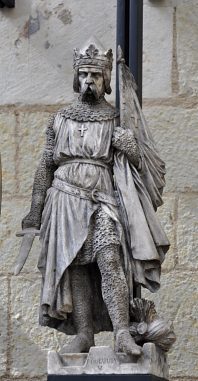 , King of Jerusalem. But this title was bestowed through marriage to the daughter of the previous King of Jerusalem, Baldwin, who did have a direct male succession from the Merovingian Kings. Henry II's claim to France was based on hiding this truth; his claim to blood descent was untruthful but politically worth making if the facts could be obscured. However, in a more relevant light, his son Richard did embody a true claim, because his mother, Eleanor of Aquitaine, was descended from Charlemagne and Clovis, the first Frank to convert to Christianity as the Carolingians usurped the Merovingian Kings. The Plantagenet's established their Merovingian / Carolingian heritage through Eleanor of Aquitaine; so it was a valid claim through Richard...but he was not yet king, for Henry II the liar, the cheating chancer even though his grandfather had married the daughter of a legitimate lineal male descendant of the Merovingian line and thus became the third King of Jerusalem after Godfroi and Baldwin, was not a true heir and he knew it.
, King of Jerusalem. But this title was bestowed through marriage to the daughter of the previous King of Jerusalem, Baldwin, who did have a direct male succession from the Merovingian Kings. Henry II's claim to France was based on hiding this truth; his claim to blood descent was untruthful but politically worth making if the facts could be obscured. However, in a more relevant light, his son Richard did embody a true claim, because his mother, Eleanor of Aquitaine, was descended from Charlemagne and Clovis, the first Frank to convert to Christianity as the Carolingians usurped the Merovingian Kings. The Plantagenet's established their Merovingian / Carolingian heritage through Eleanor of Aquitaine; so it was a valid claim through Richard...but he was not yet king, for Henry II the liar, the cheating chancer even though his grandfather had married the daughter of a legitimate lineal male descendant of the Merovingian line and thus became the third King of Jerusalem after Godfroi and Baldwin, was not a true heir and he knew it.
So, we can see here the whole basis of the Masonic doctrine is based on the Merovingian / Carolingian bloodline of super liars...George Bush, Bill Clinton, Al Gore, the current monarchs of Europe etc. These people of this fantasy bloodline we do not want in any power positions at all, so we have to undo the nonsense created in this world by the Merovingian / Carolingians bloodlines and all their offshoots.
So what of the man Leonardo de Vinci? He was for sure a very high adept, proven when one considers his golden mean picture actually has a female behind the man (seek out Dr Len horowitz.com). So Dan Brown what has he exposed? He has given us insight into the world of the shadow and how they diss-function as spiritual beings. This is why King Phillip of France held great animosity towards Henry and Richard, they were liars. Phillip, too, was descended from Charlemagne. Only two or three, females stood in the decent line between Phillip and the Merovingian Kings. He believed his claim on France was more pure than the Plantagenet usurpers. (Not true, since Eleanor's other line back through Bernard Plantevelue was probably all male.) Thus the elm at Gisors, ancient symbol of genetic branching and direct continuity, was cut in a statement to Henry II, thus:
"Fuck off Henry you lying cheating chancer"
The outward visible symbol of the vine transplanted from the Holy Land was no more. The knowledge thereafter was hidden, though preserved by the Templars and, later, by the Priory of Sion. The outer Templar order was then destroyed by King Phillipe Le Bel of France, in 1307, while the inner circle operatives spread across the globe. Sion appears to have been at the nexus of two French antimonarchical movements, the Compagnie du St.-Sacrament of the 17th century - acting on behalf on the Guise-Lorraine families - and the Fronde of the 18th, as well as behind an attempt to make the Hapsburgs emperors of all Europe in the 19th - the Hieron du Val d'Or. So one can see the connections between Sion and numerous secret societies and orders across the European minds, including; Rosicrucianism, Freemasonry, Arthur and the grail legends which were the result of Eleanor of Aquitaine commissioning French poets and writers to help in their control of the British people [See my L-TAT above] who were wishing for the return of their hero Arthur, Arcadianism, Catharism, chivalry. All these societies emanating directly from the esoteric mystery school from Egypt.
So who controlled all these organisations? The Vatican...they controlled the knowledge and therefore controlled all that would spawn from the mystery schools, but who controls the Vatican? Easy, the Imperial hybrid Nephilim bloodlines from ancient Sumer. For more proof of this fact, why would this mysterious secret society bring itself to light in 1956 and to be listed with the French directory of organisations under the subtitle 'Chivalry of Catholic Rules and Institutions of the Independent and Traditionalist Union', which in French abbreviates to 'circuit' - the name of the magazine distributed among members. Depending on what statutes one considers, Sion either has 9,841 members in nine grades, or 1,093 members in seven, with the supreme member, the Nautonnier or Grand Master of the Order being Jean Cocteau .
.
While it was believed the head was Pierre Plantard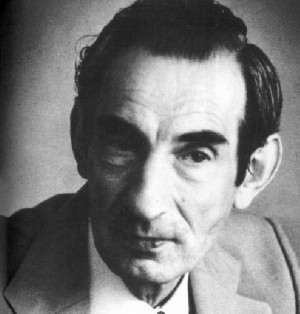 de St.-Clair, he said he left that post in 1984, so it is not clear who runs the organisation at this time, we are not meant to know they want you to seek, which takes you out of the game in relation to seeing what is going on all around you presently...A diversion.. Of course there is much information to show Pierre as a fraud, which is for sure the qualification required to be an active member of these operations.
de St.-Clair, he said he left that post in 1984, so it is not clear who runs the organisation at this time, we are not meant to know they want you to seek, which takes you out of the game in relation to seeing what is going on all around you presently...A diversion.. Of course there is much information to show Pierre as a fraud, which is for sure the qualification required to be an active member of these operations.
Some interesting things have come to light about the Priory recently. One is that the Swiss Grand Lodge Alpina (GLA), the highest body of Swiss Freemasonry may have been the recruiting body for the Priory. But the GLA is also said by some to be the meeting place of the 'Gnomes of Zurich' who are said to be the Elite of Swiss bankers and international financiers. The GLA is said by David Yallop to be the body which controlled the P2 Masonic Lodge in Italy and Monte Carlo.
One of the most interesting people to write about the Prieure may be Michael Lamy. He claims that Jules Verne was a member of both the Prieure and the Illuminati. Further, he maintains that the Prieure's politics must be understood as Orleanist, which he describes as "aristocratic, anarchistic, and Nietzschean." Perhaps it all becomes most clear when Lamy reveals to the reader that the true secret of the village of Rennes-le-Chateau is that the extinct volcano Mount Bugarach leads down into the many catacombs, to the realm of supermen, or the pure bred Elohim race. Ean Begg feels it is connected with many of the Black Virgin sites all over Europe. Certainly, if the organisation's full name is the 'Prieure de Notre Dame du Sion', and if it is that the site of Orval is connected to the worship of the bear-goddess Arduina, worshipped by the Sicambrian Franks and their Merovingian / Carolingian kings, then it could be possible. There are hints, of course, that Notre Dame is not the mother of Jesus, but Mary of Bethany AKA Magdalene a princess of the tribe of Benjamin, which is itself notorious for an outbreak of goddess-idolatry in the period of the Judges. That Mary may also be the one also known to the Gypsies of the south of France as one of the three 'Maries-de-la-Mer,' whom they call 'Sarah the Egyptian', the sun-burnt one. Or the daughter of Jesus.
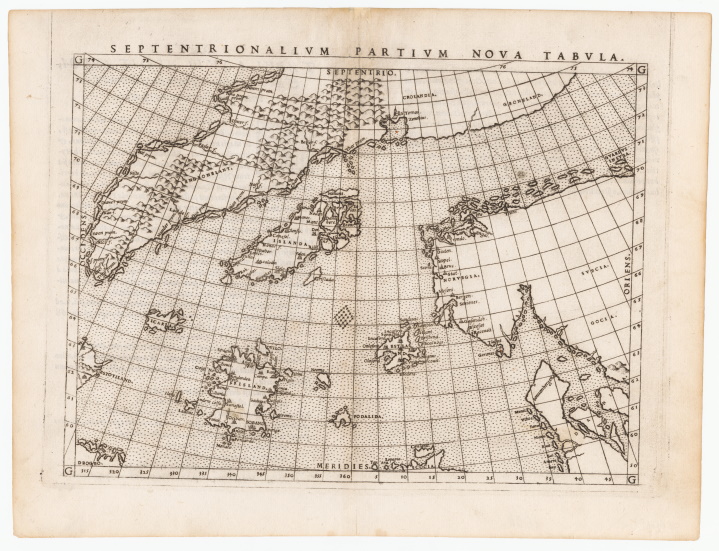
The Sinclair's of Scotland are hereditary lords of Rosslyn Chapel and are said to be descended from the Scots Guards, a clique loyal to the Stuart dynasty, which in turn are thought to have contained converted members of the Templar Order who fought with Robert the Bruce at Bannockburn, and to have provided the basis of Freemasonry. Along with the supposed visits of Prince Madoc of Wales and St. Brendan of Ireland, Prince Henry the Navigator's trip to the New World with the Zeno brothers makes it one of numerous European pre-Columbian voyages. Sinclair took a liking to the new world and decided to stay. Many of the members of his expedition wanted to return home. He allowed them to leave and kept two of the smaller boats for himself, and those choosing to remain with him. He established a base and started exploring the surrounding areas giving especial investigation to the lakes, rivers, and inlets. Sinclair's base could have included a fortress of some description, made from timber, and most possibly built on the peninsula between the Gold and Gaperau Rivers. Proof of this can be ascertained by clues at the mouth of each of these rivers, which have islands, both named Oak Island and the fact the only Islands in Nova Scotia with Oak Trees, are to be found here.
So we can assume rife within this society was the Druidic paganism. At the confluence is a mysterious ruin and quite possibly the site of his fortress. Henry mixed well with the natives and became friends with the local Indians, the Micmacs, and is believed that Henry was called 'Glooscap' by them, the name of the white God of their ancient lore. And supposedly they loved him almost as if he were a god. So we can see this as nothing other than a piece in the jigsaw puzzle began at the times of the Tower of Babel, in which man was dispersed across the globe by the Elohim and given the story of their return, as was carried out in South America upon the Maya, and indeed across the African continent. To study the knowledge of the aboriginal races gives conclusive proof of just this scenario.
Henry Sinclair and his crew remained in Nova Scotia for almost a year. Over the winter months they had built a larger ship and in the spring they sailed south to explore. I feel Henry Sinclair was a good man albeit handled by the Zeno family members, who would take back the knowledge they had found of the new world to the Illuminati families of Venice. From this first encounter would begin the plans to conquer the North American Landmass. The same with Sir Walter Raleigh, who I feel was a good hearted man who set off for the Americas himself, probably having studied the tale of Henry Sinclair.
So one can see, all good men of their respective times have wished to leave the slavery of the Nephilim bloodlines, in this time today we can do just that if we come together. You have to re-activate your DNA memories of this battle, and not allow the Illuminati to decide who your enemy is. They sailed to what is the present day New England, just north of Boston. Their relations again with the Indians were very good. At this point one of the crew Sir James Gunn died (said to be related). He was buried near the top of Prospect Hill in current day Westford, Massachusetts. A grave marker in the style of the Templars was hand chiselled onto a rock slab. The image on the rock is of a Knight Templar, bearing the arms of the Gunn Clan on his Shield.
Sinclair sailed back to Scotland, where he died in 1401 while dealing with English invaders. So we can plainly see that there are solid strands connecting Rennes-le-Chateau and the New World Order. The Rosicrucian ideas behind the American experiment are one and the same because as I have put forward...they are all the same at the highest levels. One researcher insists that the inventor Barnes Wallis was one of the most recent Grand Masters of Sion. Others have even found connections to the so-called Baconian Theory, which suggests that Sir Francis Bacon and John Dee wrote Shakespeare's plays. Bacon's works suggest a Rosicrucian experiment taking place in the New World. I would state this to be fact.
Lincoln and his co-authors supplanted the theory that Christ had children who took for exile to the south of France where they interbred with the royal Franks thus creating what eventually became the mystical Merovingian Dynasty, but as we have just seen, those today claiming Merovingian descent are not so, Charlemagne was not of the Frankish stock, he was a hybrid Carolingian who continued the usurpation of the Frankish bloodlines, thus, the real mission of the Templars and Priory of Zion, was to safeguard the treasure of the Crusades which was the blueprint for the Great Work of the Ages left in place from the times of the turmoil in Judea, and to preserve the Grail, (Nephilim female womb), which appeared in medieval texts as 'Sangraal' or 'Sangreal' - translated to mean 'sang real', or 'royal blood'.
In other words: the bloodline legacy of Christ, literally, which equates to the fact that Jesus in the Roman church version is usurpation of whomever the real man was, and transformed into a hybrid Nephilim creature. The Merovingian's / Carolingians were considered in their day to be quasi-mystical warrior-kings or as we would understand them today, black magicians, known at this time to have supernatural powers. The Merovingian's traced their ancestry back to the Benjamites who, if one studies the legend, fled from Israel to Arcadia in Greece and promptly interbred with the Greeks...no race has been left out in this hybridisation of the human form.
So to re-cap, the earliest roots of the Prieure de Sion were founded out of Hermetic or Gnostic knowledge led by a man named Ormus. This individual is said to have moulded paganism Cabbala, and Christianity after he was converted to Christianity by St Mark, he was also said to have many disciples from within the Essenes, for whom it is said were Cabbalists. This certainly rings true when you study these sects, all of whom were terrified of all things relating to the bodily functions, urine, poo, and especially semen, this is also true of the Cathars and Islam, so we can see a common root. Yet the story of Sion only comes into overt sight in the Middle Ages, with Ormus first appearing around 1770 connected with the Order of the Gold and Rosy. In 1070, a group of monks from Calabria, Italy, led by one Prince Ursus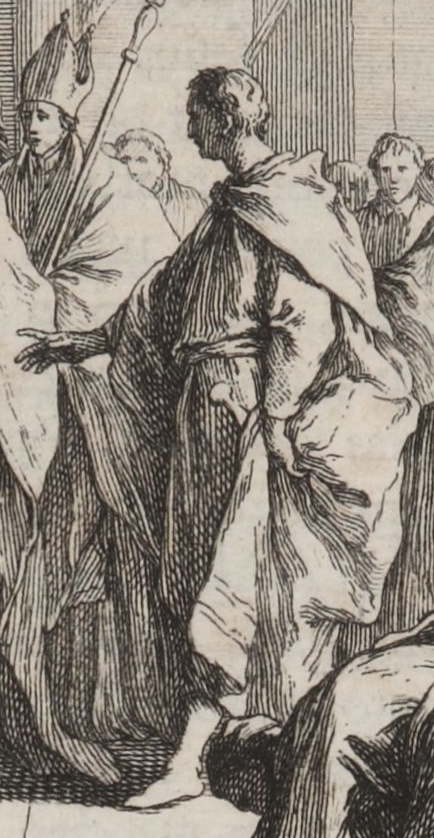 , founded the Abbey of Orval
, founded the Abbey of Orval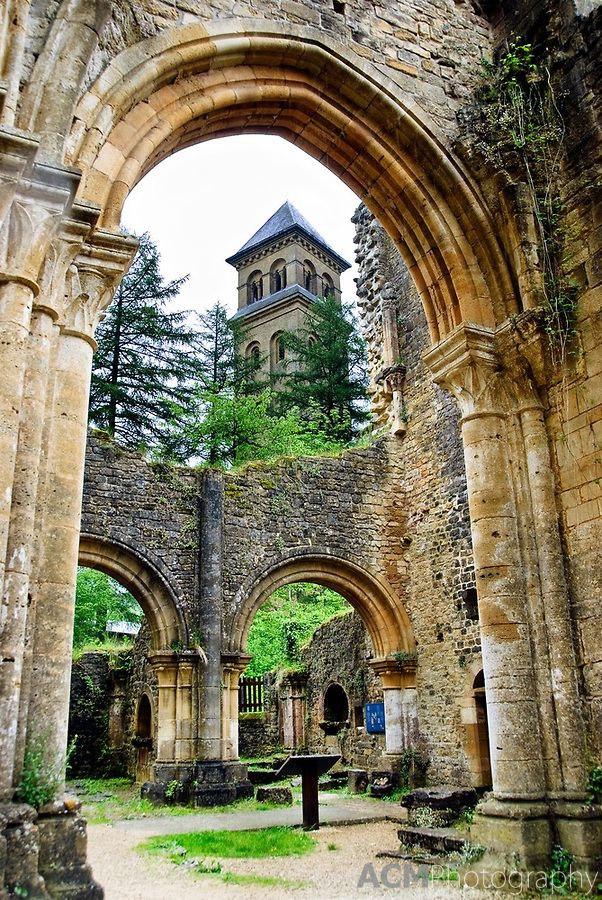 in France near Stenay, in the Ardennes. These monks are said to have formed the basis for the Order de Sion, into which they were 'folded' in 1099 by Godefroi de Bouillon
in France near Stenay, in the Ardennes. These monks are said to have formed the basis for the Order de Sion, into which they were 'folded' in 1099 by Godefroi de Bouillon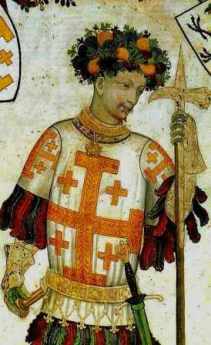 . He was one of the leaders of the First Crusade who had recaptured Jerusalem. They claim that it was this Order that lay behind Hugues of Champagne and the founding of the Templars.
. He was one of the leaders of the First Crusade who had recaptured Jerusalem. They claim that it was this Order that lay behind Hugues of Champagne and the founding of the Templars.
The avowed and declared objective of the Prieure de Sion is the restoration of the Merovingian / Carolingian dynasty and bloodline - to the throne not only of France, but across the world as ordained in the Covenant between the Anunnaki / Elohim and their hybrid creations the Nephilim, made solid with Charlemagne, the Covenant held in the 'ARK'. Now it gets interesting, because to study Egypt the Ark of the covenant is just a re-establishment of what was called the, 'Ark Of The Contract in Egypt between the Pharaohs and the Sirius gods, reverse the term God and you get 'DOG', the dog star Sirius, it's not brain surgery when one has an open mind and no fixed doctrine to limit ones own thought patterns.
The Key to all the truth of history lies in Egypt, which is the reason the Illuminati have plundered the country and flooded great swathes of the important areas, building Dams.. The holder of this, 'deed of rights' in our time giving ownership of the planet is the Vicar of Christ...the Pope, the Christ of course in their twisted fairy tale being the underground pure bred Elohim / Anunnaki, and their returning god Anu, for whom David Boyle in Blackpool operates, I know I have visited his exhibition and had communication with a entity calling itself ANU, while in his exhibition. This is what the New World Order actually is, the takeover of the planet by the priesthood from Atlantis, the priesthood of the Temple of the Sun, or the Temple of the human body beneath the heart, limiting itself to the three lower bodies, the root Chakra...Earth, the Sacral Chakra...Water, (Archangel being Gabriel, the angel who Mohammed channelled), all subservient to the Solar Plexus and the Sun god. By dint of dynastic alliances and intermarriages, this line came to include Godfroi de Bouillion, who captured Jerusalem in 1099, and various other noble and royal families, past and present. One can see the link here in that all Illuminati families today are direct descendants to Charlemagne, the lower bloodline members are seen in such people as the Bush family, Bill Clinton, Al Gore, Barack Obama, etc. all the current Monarchs across Europe are Merovingian.
So one does not require legions of knowledge to understand what the Merovingian - Carolingian creatures represent...they represent everything that is considered evil, whether one studies history of these bloodlines or just watching TV today. All the sickness that has suppressed this planet have afforded themselves long and grand titles, it goes with the territory of insisting all man sees them as fantastic, because they know what in truth they are. So this nonsense only continues while you believe them and pander to their sickness. Are we not supposed to help them see their ignorance? Or are they beyond redemption?
Godefroi according to legend, was a member of the Grail Family, and by lineage a Merovingian / Carolingian and apparently, rightful King of Jerusalem by his descent from David. It is clear that he was aware of this. When he left for the first crusade, he sold all his property because he fully intended to stay in Jerusalem. Godefroi was close to de Payen and the count of Champagne, while Baldwin (Baudouin) his brother also played an integral role in the founding of the Templars. One might therefore term Godefroi de Bouillon as a sort of 'king of kings', or at least a maker of kings, since he founded the Order of Sion that could crown Kings of Jerusalem, so we are talking Anti-Christ here. This leaves us with two possibilities, either Ralph Ellis is correct and we are dealing with the Egyptian Hyksos in relation to Jesus, or the whole thing is an invention. To the south of Jerusalemwe find the 'high hill' of Mount Sion. By 1099 an abbey had been built on the ruins of an old Byzantine basilica on command of Godfroi de Bouillon. According to one chronicler, writing in 1172, it was extremely well fortified, with its own walls, towers and battlements, and that this structure was called the Abbey of Notre Dame du Mont de Sion. In 1979, M. Plantard said to us, quite categorically, that the Prieure was in possession of the treasure of the Temple of Jerusalem, plundered by the Romans during the revolt of A.D. 66, and subsequently removed to the south of France, in the vicinity of Rennes-le-Château. The treasure, M. Plantard stated, would be returned to Israel when the time is right. So we are dealing here with bloodline and the written agreement between the Nephilim and the Anunnaki, Siriun gods better known as the Ark ...in which resides the Covenant.
At some point the treasure had passed from the Merovingian's to the Priory of Zion., who are one and the same at elite level. The Templars took the treasure from the Holy Land to the French Cathars, who, on the eve of their destruction by the church, removed the treasure to in the Pyrenees. The Sudan also claims to hold the great treasure. So to recap, for around hundred years, the Order of the Temple (Knights Templar) and Sion were unified under one leadership, but because of the greed of King Henry II when he tried to deceive the other greedy man who happened to be French, they are said to have separated at the 'cutting of the elm' at Gisors in 1188.
This is the strategy of the Illuminati to a tee, complete and utter strategy one finds right through history. Create an organisation then split it in two to scupper the descent that always comes about after a time when one is playing a lie. Thus the amount of minds one controls doubles rather quickly...poetry. Near the end of the thirteenth Century a separate detachment of Templars was sent from the Aragonese province of Rossillon to the Rennes-le-Chateau area in southern France (the old Cathar stronghold). This fresh detachment established itself on the summit of the mountain of Bezu, erecting a lookout post and a chapel. What is rather strange is that of all the Templars in France, they were left unmolested by Philippe le Bel's deadly decree on October 13, 1307. But as I have stated throughout my work, it was only the good Templars that were killed, the Illuminised Templars were spread across the globe, because they knew that across the European /Asian landmass there was a great hatred for Rome, and thus all escaping Templars would be helped by those who opposed Rome. This enabled the Templar elite to instill themselves at the center of all the rebellious places across the globe. This in turn placed the Illuminati slap bang in the center of their enemies, and the lending of monies began in earnest and control of all the enemies of Rome...in time accomplished, and still to this day the deception of this event holds sway, well at least until you read this work! It holds sway because this and all other historical events are embedded in the DNA, so when you watch films like Gladiator, the DNA remembers and re-activates those memories...they become you once again. That is how they control your DNA; by regurgitating old historical events your DNA has memories of, while twisting the stories to serve their next moves in the game.
On that fateful day the commander of the Templar garrison at Bezu was a Seigneur de Goth. And before taking the name of Pope Clement V, the archbishop of Bordeaux - King Philippe's vacillating pawn - was Bertrand de Goth. Moreover, the new pontiff's mother was Ida de Blanchefort, of the same family as Bertrand de Blanchefort [the fourth Grand Master of the Order of the Temple]. Was the pope then privy to some secret entrusted to the custody of his family? Whether it was the intrigues and the Wars of Religion in the sixteenth century, the insurrection known as the Fronde in the seventeenth century or the Masonic conspiracies of the eighteenth century, successive generations of precisely the same families were implicated, operating in accordance with a single consistent pattern.
In documents dating from 1619, it was stated to have upset King Louis XIII of France, who evicted them from their seat at Orleans and turned the premises over to the Jesuits, the commanding military wing of the Nephilim. After that, the Prieure de Sion seemed to vanish from the historical record, at least under that name, until 1956, when it appeared again, registered in the French Journal officie. The castles of Templar Chateau of Bezu, the Chateau of Blanchefort, and Rennes-le-Chateau are each located on a mountain top. Together, with the high spots of two other peaks, the locations form a perfect pentagon (five equal sides, which is found in the center of a pentagram, a very satanic symbol representing Baphomet, the composite symbol of the negative force, Lucifer) some fifteen miles in circumference. Like Rennes-le-Chateau, the village church dates back to the time of the Visigoths, around thirteen centuries ago. The church is dedicated to Saint Magdalene. The early Vatican commissioned astronomers saw the Earth as the center of the universe, around which the Sun, the stars and the planets revolved. Each planet forms its own pattern of movement around the Sun as seen from the Earth. For the ancient watchers of the heavens, those differing patterns of movement allowed them to draw geometric shapes based on the positions of each planet when it was aligned with the Sun. Only one planet describes a precise and regular geometric pattern in the sky - and that planet is Venus, the heavenly counterpart of the earthly Mary Magdalene - and the pattern that she draws as regular as clockwork every eight years is a pentacle. Venus according to Masonic law is Lucifer, the light bringer for it heralds the rising Sun, and is thus said by the ancients to be the light bringer bringing the Sun behind it each morning. There can be no doubt that churches, calvaires, castles and ruins - almost every structure of importance upon the map, form an intricate web of alignments which intersect with perfect regularity on the zero Paris- meridian.
The distance covered by three of those divisions is the circle radius measure. Each point is separated from the next by exactly one third of 933.586 poles. The accepted definition of a pole - also known as the Rod or Perch- is now 5.5 yards. All of the measurements and placements of the buildings follow the patterns of the sacred geometry. This all leads back to the Hermetic studies - Hermes who was Thoth, the ancient Egyptian, Alchemy, the Ark of the Covenant, and the Cabbalistic Tree of Life. The boat of Isis was positioned in the constellation of Argo. Specifically, in Egypt this constellation was named Sothis or Soth-Isis, the Star of Isis, Sirius. Furthermore, in the Egyptian legends this vessel represented the female organ of generation. The Ark of the Covenant of the ancient Israelites is the Egyptian Ark of the Contract between the Pharaohs and the five neters, the five gods of Sirius, of course in the deception played in superimposing so-called Judeo patriarchs over Egyptian Pharaohs, this had to be so.
More astrological significance can be found with the Sun receiving the 'Kiss of Death' in Scorpio, (thus symbolised with the Mafia who always kiss you before they kill you), then the sun enters its death in Capricorn the Goat... the Winter Solstice. The Sun then rises at the same degree on the 22-23 and 24th of December, and is said to have died (the lowest level in the Northern hemisphere), the Sun then on the 25th rises one degree, and is said to be reborn (its birthday) then its ascension (rising higher in the sky each day) until we get to Easter the Spring Equinox, (under Aries the ram, represented as the lamb, in that the Sun at this point is said to be only a young boy) the celebration of Ishtar, the Anunnaki goddess, thus this event is called, 'the resurrection by Christians, because from the crossing of the Spring Equinox, there is more Sun light in each day than darkness (night). Thus travelling onto the Summer Solstice, the height of the Suns power, (said to be a full adult) and a gradual decline in its power (edging into old age) until it reaches the Autumn Equinox in the house of Virgo (Delilah), when more darkness is then in play, and the Sun is said to have its rays (hair) symbolically cut and on again to it's death in Capricorn on the Winter Solstice, where it remains in the cave for three days (22-23-24th December), and is reborn...it's birthday.
Now can you understand the implementation of the Romanised SYMBOLIC JESUS over the pagan celebration of the cycle of the SUN? This is the reason I call the Jesus from the Church of Peter, The Symbolic Jesus, because it bares no truth on the actual rebel initiate from the Nazarene sect, which was Egyptian in its doctrine. The fantasy as laid out by the Church of Rome is to hide these facts, and bring unto themselves all the loving energy that was awarded to the rebel. We shall enter another reason the Church fabricated the story later in this Phase, as we journey through the Egyptian links. (See EGYPT page)
It is thought that Hugues de Payens , first Grand Master of the Knights Templar, had been inducted into the Johannites, the sect which chose John the Baptist as their prophet. According to the dossiers secrets, each of the alleged Grand Masters of the Prieure de Sion took the name Jean in succession supposedly influencing the name chosen by Pope John XXIII. One of the Grand Masters on the list, Leonardo da Vinci, displayed a strong interest in John the Baptist. Another, Sir Isaac Newton, became preoccupied with the writings of the Apocalypse, at the time, attributed to John the Evangelist.
, first Grand Master of the Knights Templar, had been inducted into the Johannites, the sect which chose John the Baptist as their prophet. According to the dossiers secrets, each of the alleged Grand Masters of the Prieure de Sion took the name Jean in succession supposedly influencing the name chosen by Pope John XXIII. One of the Grand Masters on the list, Leonardo da Vinci, displayed a strong interest in John the Baptist. Another, Sir Isaac Newton, became preoccupied with the writings of the Apocalypse, at the time, attributed to John the Evangelist.

René d'Anjou (1418-80) - a major impetus behind the Renaissance through his literacy and influence on Cosimo de'Medici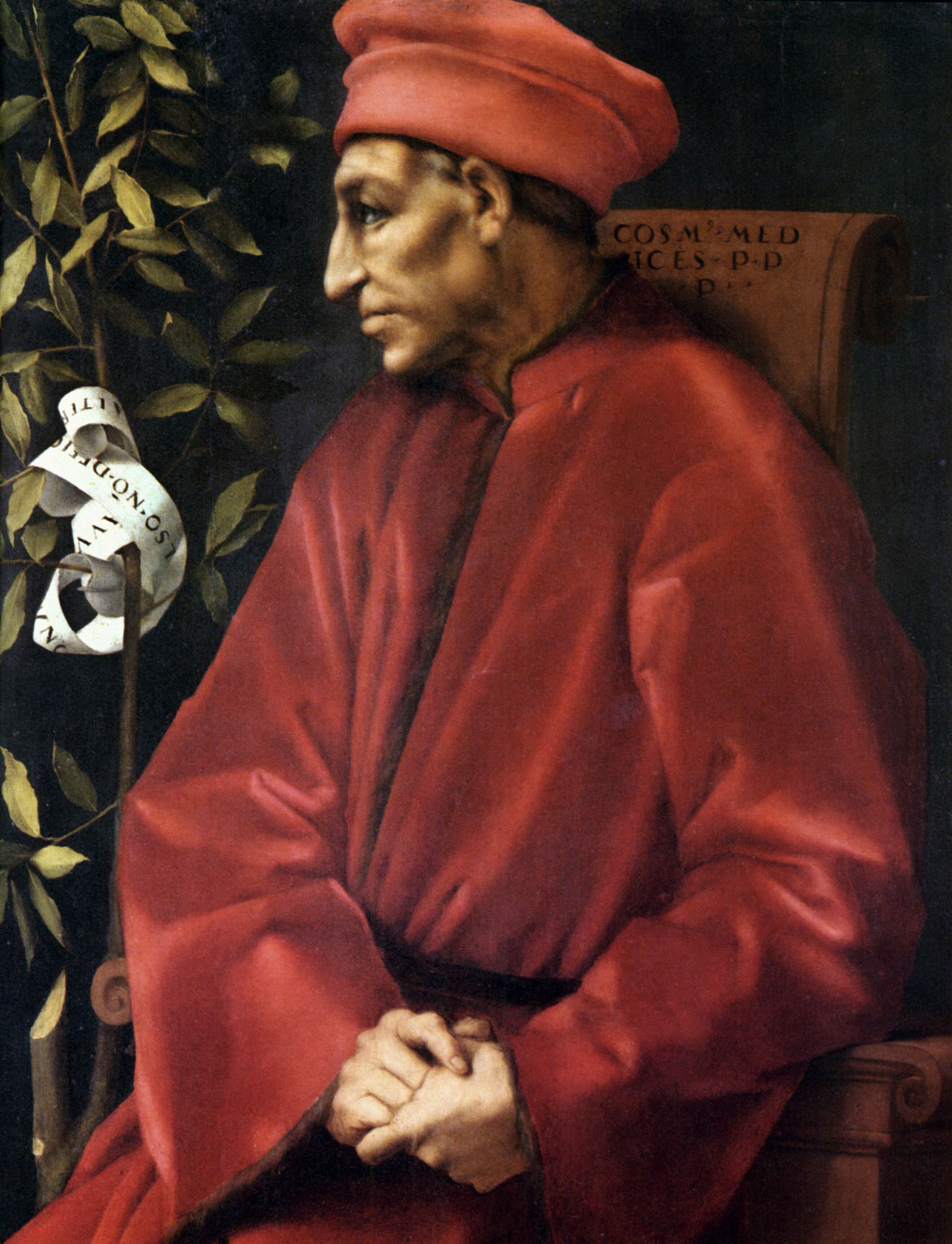 setting up bastions of esoteric, Hermetic principles - the 'underground stream'. His influence stemmed from his title, 'King of Jerusalem to which all bloodlines are subordinate, and reason the next Pope after this one will take its seat in Jerusalem. Legend records that the d'Anjous were descended from Ann the Jew, daughter of Joseph of Arimathea, who supposedly carried the Davidic blood line and settled in western France. Later, the D'Anjou branched into the Houses of de Guise and de Lorraine. René d'Anjou was related to the king of France by marriage and remained a trusted ally during the war with England. I have covered his relationship to his puppet Joan of Arc in an earlier phase. What is very clear, René was one of the most powerful men in Europe at his time, showing itself in his title 'King of Jerusalem. After the failure of his Italian campaign, he took his public leave and to the masses of the time became nothing other than a patron of the arts and collector of books. René was co-sponsor of the Arcadia revival in the late 15th century. Through his patronage of art, literature and the advancement of knowledge Rene is one of the most important figures of the formative years of the Renaissance. It was Rene's command of the bloodlines that ensured Cosimo de Medici sent agents out to look for ancient texts, which resulted in the revival of Neoplatonic and Hermetic thought.
setting up bastions of esoteric, Hermetic principles - the 'underground stream'. His influence stemmed from his title, 'King of Jerusalem to which all bloodlines are subordinate, and reason the next Pope after this one will take its seat in Jerusalem. Legend records that the d'Anjous were descended from Ann the Jew, daughter of Joseph of Arimathea, who supposedly carried the Davidic blood line and settled in western France. Later, the D'Anjou branched into the Houses of de Guise and de Lorraine. René d'Anjou was related to the king of France by marriage and remained a trusted ally during the war with England. I have covered his relationship to his puppet Joan of Arc in an earlier phase. What is very clear, René was one of the most powerful men in Europe at his time, showing itself in his title 'King of Jerusalem. After the failure of his Italian campaign, he took his public leave and to the masses of the time became nothing other than a patron of the arts and collector of books. René was co-sponsor of the Arcadia revival in the late 15th century. Through his patronage of art, literature and the advancement of knowledge Rene is one of the most important figures of the formative years of the Renaissance. It was Rene's command of the bloodlines that ensured Cosimo de Medici sent agents out to look for ancient texts, which resulted in the revival of Neoplatonic and Hermetic thought.

Nicholas Flamel (1330-1418) certainly one of the most famous historical alchemists, 'claimed that he dreamed of an occult book, subsequently found it, and succeeded in deciphering it with the aid of a Jewish scholar learned in the mystic Hebrew writings known as the Kabbala. (Very reminiscent of the Book of Mormon in its tale). In 1382 Flamel claimed to have succeeded in the 'Great Work' (gold making); certainly he became rich and made donations to churches. There are many and a growing number of learned men who equate the true 'Alchemy' with the art of shape shifting, the ability of the hybrid bloodlines to control their DNA to the point of a shift in its codes. This of course for those with a 50-50 mix between human and dragon DNA, (the Nefilim) is the whole basis of the elite bloodlines incestuous breeding... to keep this ability in tact. The metal relates to the copper content within the 'Blue Blood', which by use of the mind and will, can achieve what they term Gold, and the ability to change form? Copper is still one of the best means of transmitting electrical signals, and so must have a similar effect within the blood. An ex Montauk Project operative, Stewart Swerdlow claims most humans alive today, have between 15-20% of their genetic makeup from the dragon race, I would add this to be the consequence of the fifth root race to which most humans today belong, the product of the hybridisation after the flood and on through to today, and the real aim of the genetics programmes through history albeit by natural means of pro-creation, until they re-built their science and gained the ability to play this game in the laboratory, as the Sumer tablets tell quite clearly they did pre-flood. This makes a lot more sense as to why the Illuminati have through the ages instigated such massive wars of complete genocide within all nations, to ensure the demolition of all traces of the previous four root races...what do you think?
It certainly dissolves the mystery of such murderous wars of history, and gives a greater understanding as to the meaning of such idiots as Alistair Crowley when he stated; "the First and Second World wars are essential for the work of GOD", a sentiment taken up by many in the so-called New Age Movement...what bollocks, but does seem to ring true when one looks at history, all wars are for God. This being so, gives the real reason the African and Asian races are to be culled presently.... According to the Sumer tablets, the Anunnaki placed their genetics first into the African race, and forced the blood rites upon them, they infused a higher level of their genetics into the Lemurian race, today the Chinese and Japanese races, and instilled the worship of the Dragon, and us poor Caucasians had the largest amount of this fallen angel DNA, proving itself in the fact we are by far the more warrior race of the lot, and have thus been used the most by this tribe of insanity.
That is the history; the genetic imbalance is across the globe today, in all races. They have slaughtered the older bloodlines through at least the last 7000 years. Whatever the real meaning, we do know is this tribe of domination have throughout history placed hideous dragon sculptures and indeed have their coat of arms depicting such, there has to be more to this than we have been allowed to know, although I feel they are slowly placing it in the system for the finale of the New World Order, so we accept them as the overlords.
One alchemical symbol is that of an old bearded man, the back of whose head shows a young woman looking into a mirror. A statue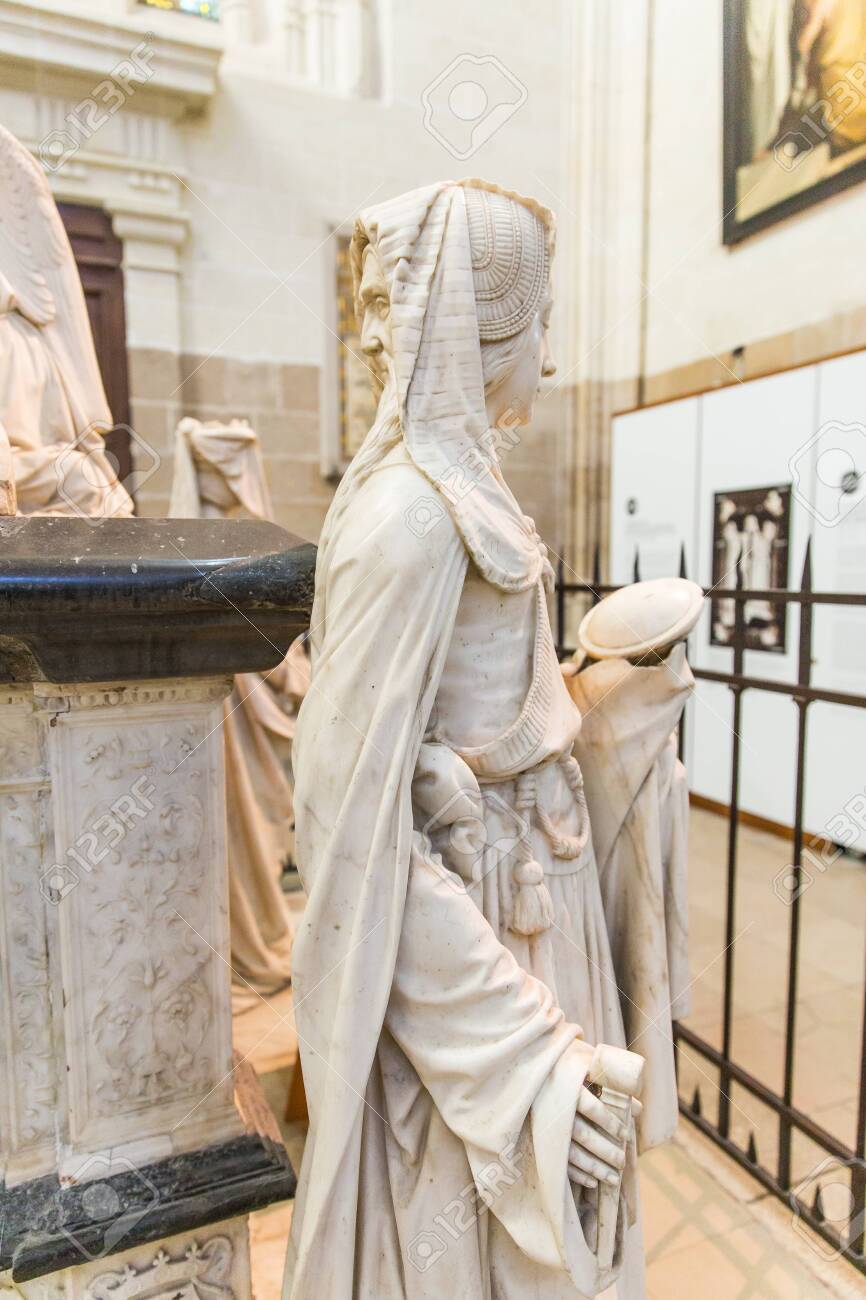 with this image graces the exterior of Nantes cathedral, as does a bearded king with the body of a woman, in the porch at Chartres that is said to depict the Queen of Sheba. The hermaphrodite is a pure alchemical symbol, representing the perfect balance achieved in the Great Work, and the perfect being, in which the alchemist himself is transformed and transmuted spiritually - and, as many believe, physically as well, yet another hint at the ability to physically shift ones DNA.
with this image graces the exterior of Nantes cathedral, as does a bearded king with the body of a woman, in the porch at Chartres that is said to depict the Queen of Sheba. The hermaphrodite is a pure alchemical symbol, representing the perfect balance achieved in the Great Work, and the perfect being, in which the alchemist himself is transformed and transmuted spiritually - and, as many believe, physically as well, yet another hint at the ability to physically shift ones DNA.
What is known about the pure breed reptile race is they are hermaphrodite. It was a 'consummation devoutly to be wished' and had little, if anything, to do with sexuality as we understand it today. Interestingly The Zulu sanusi, Credo Mutwa says of an African legend, that the gods came down and tricked them to enter some kind of a machine which divided the sexes into male and female, thus suggesting man was once hermaphrodite? The Great Work was an explosion of the potential into the actual, where the mystical quest takes on concrete form. As the alchemists said, 'as above, so below' - this process was believed to make spirit into matter and transmute one sort of matter into another, we are talking ability to control sound here which is the basis of this whole vibratory reality.
According to Masonic law 666 is the key to sound, therefore the key to manipulating matter. When one begins to fully understand HAARP, then one can understand why 666 is the number of the beast, and the beast can control our DNA via sound or frequency manipulation. This gives the mobile phone networks a whole new meaning, especially with the fact this network operates in sync with HAARP. So Alchemy in its true meaning is the ability to turn matter into spirit and thus made man into god....the reptiles demand we call them GOD? We are talking shapeshifting hear, which gives a whole higher level understanding of the Golden Bough, and astral travel, to which I feel the Emerald tablets of Thoth are describing. So let us say 666 is the enemy of the evil ones in reality, and they have all mankind ready to fight this, are we not in fact speaking in terms of the earth shifting frequency moving out of matter, from the third dimension to the fourth, something the Children of the Shadows do not want, because they feed from the abyss, or what is termed; 'lower fourth' into this dimension, feeding off the energy of mans electromagnetic field or; 'Aura'.
If man shifts above these creatures frequency, they cannot feed off a higher frequency and so will be no more in this dimension. Now many feel this means we will disappear, but if the earth shifts as one, we would know no difference; we would just extricate our spirit out of a dense vibration with everything in tact. This I feel is what they are afraid of and all this madness is to block the shift, HAARP is part of this. Did they do this before, is this what created the cataclysms, they prevented the shift and so we had the dark age of the last 12.500 years and the catastrophic earth changes ending with the earth flipping and creating the deluge. It would answer the reason there are traces of glaciers in Western directions.

Now this brings us into a very well known symbol, but I doubt it is widely understood; 'The Sword in the Stone'. This is also symbolic of this very spiritual act, but on a personal level, whereby the higher aspect of oneself removes itself from the control of the denser vibrations represented as solid stone, or control of the DNA programming by the inner or higher spirit. Who you really are becomes master of the matrix encoded in the DNA, you ride your horse. In Arthur this shows itself in great abilities and able to lead people into great things, great accomplishments. One has become aware at a higher vibration, and things can be decoded and brought into this frequency while living, one becomes a 'Shaman', not I may add a Shaman through the ritual sense of initiating, but through constantly moving to raise ones vibration within oneself. Is not the kingdom of god within? It is a state of awareness, or consciousness experiencing this dimension and yet all the while you have full connection to the very source of all that is, on every level, you have just forgotten, stuck as a slave to your genetics. God the creator 'is' the essence of everything... we are it.

Leonardo de Vinci (1510-19) - Having little formal education, Leonardo enthusiastically accepted Nicholas's of Cusa new worldview of an universe with no limits in space, no beginning or ending in time, as a justification for rejecting the outmoded authority of the 'Pharisees - the 'holy friars' and of his 'adversaries' Plato and Aristotle. For the first time since the Ionians, he put forward a conception of science that was completely secular, not based on religious doctrines or philosophy. Leonardo de Vinci was left-handed and was a strict vegetarian. He sought the company of alchemists and necromancers; worked on a Sunday and only attended Mass when at court. The only surviving sculpture that involved Leonardo in its creation is the statue of John the Baptist found today in the Baptistery in Florence, on which he collaborated with the utmost secrecy with Giovan Francesco Rustici, a known necromancer and alchemist. Leonardo's last painting was 'John the Baptist', showing him with the same half-smile as 'The Mona Lisa', and pointing straight upwards with the index finger of his right hand, the index finger represents Jupiter.
This in Leonardo's work is a sign always associated with John: in the 'Adoration of the Magi', Zeus, a person stands by the elevated roots of a carob tree - John's tree, symbol of sacrificial blood - while making this gesture. In his famous cartoon of St. Anne the subject also does this, warning an oblivious Virgin. What must be understood here, is that all this esoteric symbolism directly relates to the blood sacrifices of humans, especially young virgin children, the best of which are always those with blonde hair blue eyes and red hair and either green or blue eyes, it is a sick punishment in retaliation for their defeat by St George all those years ago, and such genetics have certain enzymes they require for their blood drinking. As I am writing this section there is the news report in relation to the child abuse on the Island of Jersey, with information in relation to children being isolated from 24 hours up to two months. There are also bodies being found within the complex. It really is time for you to accept this abuse as endemic throughout the world, not just in Jersey. This is what they have always done...this is why only those with the correct mindset move up into the higher echelons of power throughout all organisations. Surely it is time for you all to allow yourselves to see this then we can act to destroy it and ensure all these sick people spend the rest of their lives in prison. They will not cease in this behavior, we have to stop them, for good.
The disciple whose face is perhaps accusingly close to Jesus' in 'The Last Supper' is also making this gesture. All these gestures are said to be saying 'remember John', although I have written this is also symbolic of Jupiter...Zeus.

Johann Valentin Andrea (1637-54). Creator of the pseudo-secret Christian unions and so-called author of the Rosicrucian manifestos, which are a Hermetic allegory evoking resonance with the Grail Romances and the Knights Templar. At this time, as the House of Lorraine began to disappear into a more covert role, the Priory transferred its allegiance to the more influential Stuarts after Frederick of the Palatinate married Elizabeth Stuart, daughter of James I of England. Frederick created a culture, a 'Rosicrucian' state with its court cantered on Heidelberg.

Robert Boyle (1654-91) – member of the 'Invisible College' made up of the most sleazy and satanic English and European minds which would emerge as the Royal Society, the society responsible for the carbon emissions as cause for global warming. Charles II would become its patron and sponsor. His two closest friends were Isaac Newton and John Locke who met regularly with him to study alchemical works. In the ancient world alchemy was referred to simply as 'the sacred art'. It flourished in the first three centuries A.D. in Alexandria, where it was the cover for high end satanic activity. It was portrayed to the masses to be the science that combined products of glass and metal technology, again taken in its symbolic understanding equates to glass, the looking glass, and metal being copper of which these hybrid bloodlines have a massive content.

Canvas Tuileries 1812
When it comes to NAPOLEON BONAPARTE, Sion appears to have been at the root of two French anti-monarchical movements, the Compagnie du St.-Sacrament of the 17th century acting on behalf on the Guise-Lorraine families, and the Fronde of the 18th, as well as an attempt to make the Hapsburgs emperors of all Europe in the 19th- the Hieron du Val d'Or. In 1796 Napoleon was one of three revolutionary 'Directors' heading the government. Another 'Director' was Abbe Sieyes, who knew of certain genealogical researches that had been undertaken by one Abbe Pichon. Pichon had access to the royal archives captured by the revolutionary government, where some important genealogies had been hidden away, and he discovered that a direct descent from Dagobart II had been maintained up to then. Abbe Seiyes urged Napoleon to marry Josephine Beauharnais (formerly Josephine Tascher de la Pagerie) because she was a Merovingian / Carolingian descendant, and to adopt her two children by a previous marriage to General de Beauharnais who was of this anciently royal stock. In 1798 on the way to Egypt, Bonaparte detoured to capture Malta and the treasure held by the Knights of Malta. Napoleon was 100% the puppet for the Illuminati with his control made so much easier with his union with Josephine. He was used to re-create the whole structure of Europe, which he accomplished in exemplary manner, then to covertly take the reigns of power again...the Illuminati defeated him via the high ranking family the House of Rothschild who ensured Wellington had all he required for victory.
During Second World War in France, a recent grand master of the Prieure de Sion, M. Plantard, was grand master of Alpha Galantes. "He hinted that beneath its pro-Vichy and Petainist patina, Vaincre [the journal of Alpha Galantes] contained coded messages and instruction which would have been decipherable only to the Resistance.
Vaincre had been printed by Poirier Murat, Chevalier of the Legion d' Honneur, holder of the Medaille Militaire and officer in the French Resistance. According to Vaincre and Alpha Galantes, chivalry was to be the instrument of national renewal for France: 'a chivalry is indispensable because our country cannot be reborn except through its knights.' In the fifth issue of Vaincre, dated 21 January 1943, a great German, one of the Masters in our Order is quoted as saying:
"It is therefore with total confidence that I depart to perform my mission; for while not deluding myself about the perils I run in discharging my duty, I know that until my last breath my watchword will consist in recognition of Alpha and fidelity to its chief".
This statement is ascribed to Hans von Moltke, a career diplomat and a cousin of Claus von Stauffenberg. Helmut James von Moltke, together with Peter Yorck von Wartenburg, was the leader of the so-called Kreisau Circle, the civilian wing of the German Resistance to Hitler. Both Alpha Galantes and the Kreisau Circle were intent on youth movements and on mobilising the resources of European youth. Both insisted on a moral and spiritual renewal, an opposition, in Moltke's words, based on fundamental principles. Both were essentially chivalric in their orientation. And both were dedicated to the eventual creation of a United States of Europe. Remembering the fact it was a Templar ambition to create the European super state, and to make legal the charge of usury on money lending.
During the Second World War, while Poher was doing something heroic in the Resistance to win the Resistance Medal and the Croix de Guerre, and while Plantard (future Nautonnier of the Priory of Sion) defied the Nazis and suffered torture for it? The Cross of Lorraine was adopted as the symbol of the Free French forces under Charles de Gaulle. The problem for man is we never understood the true length of the 'reach' of this super elite, made worse with total ignorance of the Occult. In all respects whatever organisation man approaches for backing is an operation controlled by some means by the Illuminati, the symptom of ignorance or rather operating on belief alone, whether it be, belief in a particular organisation or a specific individual.
One has to grasp the real aim of the Bavarian Illuminati and the fact that it was very successful in infiltrating both the Freemasonic and Jesuit orders...at elite level. One has to remember all the Nazis allowed to escape Germany for South America, did so with Vatican passports, once they had agreed to the terms of Operation Paperclip. This could not have been achieved if as is widely believed by Catholics, the Vatican (for which the Pope is a mere figurehead) is not high in the control of all organisations. These are the truths many have to face before one is able to investigate without your conditioned idea of reality preventing you from studying information as it presents itself to you. To grasp the truth or even see it, one has to follow the path the information takes you, and not see all negative facts in relation to that you hold dear to your heart, as merely propaganda from your perceived opposite. This is the very mechanism the elite have implanted to prevent any advancement on an individual level.
In many cases a strong belief acts as a suppressor, your limitation, and thus your prison guard. I have written about the symbolism of the double cross, it means exactly that...the double cross or to be double crossed. For yet more synchronicity, as I write this piece there is a news report about yet another medical operative having been caught killing elderly patients, this time in Leeds. As I turned to watch this report, the shot was from a helicopter looking down on the hospital, and guess what was there to be seen? Upon the roof of one building was a single cross in white, and on the other to its left, the sign of the double cross. So the symbolism of the Illuminati is everywhere, one just has to understand what to look for and you get a better picture.
It is Napoleon Bonaparte who instilled the idea that all the aristocratic families he removed from power, where actually in control, and quite probably the run of the mill personnel of these families were and perhaps are decent people. It has always been at the elite levels of these families that the Illuminati connection is achieved, kept secret from the majority of members of these great families. So we must understand this and grasp the fact it is the elite of everything that plays this game of fascism, so it follows it is the elite we have to expose, not the whole families. We cannot allow anarchy to raise its ugly head or we will be back to the dark ages. We all need each other because we cannot allow all our systems to crumble.

The cross of Lorraine having two cross-bars instead of one, originated with the ancient French house of Anjou where Guiot found his tale about Percival. It was later adopted by the Merovingian / Carolingian-descended rulers of Lorraine in the old Sicambrian heartland on the Rhine. So one can see the idea that the Elders of Zion emerged only a couple of centuries ago is nonsense, it is Sion with a new face. It is the continuation of the Babylonian Empire's scarlet preistcraft shedding its skin as it slithers through Egypt, Greece, Troy, and from Rome across the globe, shedding its skin or transforming into something else, being the key phrase here. They will have such a plan in place even now to re-appear as something else, the new age movement is part of this so keep your wits about you and believe nothing, but investigate everything allow oneself to be moved. I see it for the current time that the Anunnaki are parading as the 'saviour' returned race to uproot the Illuminati on our behalf...of course 'we' the world populations will have to hand over all power to these dragons for them to carry out this mission, when all along it is these returned Anunnaki who are the Gods of the underground Elohim / Nephilim hybrids, they are the gods to whom the Illuminati offer human sacrifice, so we must in no way fall for this under any circumstance. These hybrids were created to create the Temple for the Anunnaki to return (to the Surface) and assume the throne of Jerusalem...with our permission.
So at the point we are now at in this expose brings us to the Middle Ages, and the root of what today is called Freemasonry, a direct continuation of the Knights orders, especially the Knights Templar, for no other reason than the fact they are perceived to be the enemy of Rome after the purge by Phillip the fair in 1307. So I feel we have covered Freemasonry pretty well so far in this work. But will put forward the fact that unknown to all those who would call themselves Catholic in holding to the power of the Vatican, have fallen for the deception believing the Papal court to be it's own power, when in fact as I hope I have thus proved, it is the Imperial bloodlines who have always had control of the Popes. The Freemasons operate directly for the Imperial bloodlines, yet at low level do not see the truth that these same bloodlines also control the Vatican. Both sides operating for the very same bloodlines who throughout history have created and controlled all that is negative...always.
We need to look closely at how our behaviour is playing into this game.
To be continued
![]()
![]()
Disclaimer:
Some material presented will contain links, quotes, ideologies, etc., the contents of which should be understood to first, in their whole, reflect the views or opinions of their editors, and second, are used in my personal research as "fair use" sources only, and not espousement one way or the other. Researching for 'truth' leads one all over the place...a piece here, a piece there. As a researcher, I hunt, gather and disassemble resources, trying to put all the pieces into a coherent and logical whole. I encourage you to do the same. And please remember, these pages are only my effort to collect all the pieces I can find and see if they properly fit into the 'reality aggregate'.
Personal Position:
I've come to realize that 'truth' boils down to what we 'believe' the facts we've gathered point to. We only 'know' what we've 'experienced' firsthand. Everything else - what we read, what we watch, what we hear - is what someone else's gathered facts point to and 'they' 'believe' is 'truth', so that 'truth' seems to change in direct proportion to newly gathered facts divided by applied plausibility. Though I believe there is 'truth', until someone representing the celestial realm visibly appears and presents the heavenly records of Facts And Lies In The Order They Happened, I can't know for sure exactly what "the whole truth' on any given subject is, and what applies to me applies to everyone. Until then I'll continue to ask, "what does The Urantia Book say on the subject?"
~Gail Bird Allen
![]()
![]()














-
Urantia Book, 44:0.11 - The Celestial Artisans
Never in your long ascendancy will you lose the power to recognize your associates of former existences. Always, as you ascend inward in the scale of life, will you retain the ability to recognize and fraternize with the fellow beings of your previous and lower levels of experience. Each new translation or resurrection will add one more group of spirit beings to your vision range without in the least depriving you of the ability to recognize your friends and fellows of former estates.
-
Princess Bride 1987 Wallace Shawn (Vizzini) and Mandy Patinkin (Inigo Montoya)
Vizzini: HE DIDN'T FALL? INCONCEIVABLE.
Inigo Montoya: You keep using that word. I do not think it means what you think it means. -
Urantia Book, 117:4.14 - The Finite God
And here is mystery: The more closely man approaches God through love, the greater the reality -- actuality -- of that man. The more man withdraws from God, the more nearly he approaches nonreality -- cessation of existence. When man consecrates his will to the doing of the Father's will, when man gives God all that he has, then does God make that man more than he is.
-
Urantia Book, 167:7.4 - The Talk About Angels
"And do you not remember that I said to you once before that, if you had your spiritual eyes anointed, you would then see the heavens opened and behold the angels of God ascending and descending? It is by the ministry of the angels that one world may be kept in touch with other worlds, for have I not repeatedly told you that I have other sheep not of this fold?"
-
Urantia Book, Foreword - 0:12.12 - The Trinities
But we know that there dwells within the human mind a fragment of God, and that there sojourns with the human soul the Spirit of Truth; and we further know that these spirit forces conspire to enable material man to grasp the reality of spiritual values and to comprehend the philosophy of universe meanings. But even more certainly we know that these spirits of the Divine Presence are able to assist man in the spiritual appropriation of all truth contributory to the enhancement of the ever-progressing reality of personal religious experience—God-consciousness.
-
Urantia Book, 1:4.3 - The Mystery Of God
When you are through down here, when your course has been run in temporary form on earth, when your trial trip in the flesh is finished, when the dust that composes the mortal tabernacle "returns to the earth whence it came"; then, it is revealed, the indwelling "Spirit shall return to God who gave it." There sojourns within each moral being of this planet a fragment of God, a part and parcel of divinity. It is not yet yours by right of possession, but it is designedly intended to be one with you if you survive the mortal existence.
-
Urantia Book, 1:4.1 - The Mystery Of God
And the greatest of all the unfathomable mysteries of God is the phenomenon of the divine indwelling of mortal minds. The manner in which the Universal Father sojourns with the creatures of time is the most profound of all universe mysteries; the divine presence in the mind of man is the mystery of mysteries.
-
Urantia Book, 1:4.6 - The Mystery Of God
To every spirit being and to every mortal creature in every sphere and on every world of the universe of universes, the Universal Father reveals all of his gracious and divine self that can be discerned or comprehended by such spirit beings and by such mortal creatures. God is no respecter of persons, either spiritual or material. The divine presence which any child of the universe enjoys at any given moment is limited only by the capacity of such a creature to receive and to discern the spirit actualities of the supermaterial world.
-
Urantia Book, 11:0.1 - The Eternal Isle Of Paradise
Paradise is the eternal center of the universe of universes and the abiding place of the Universal Father, the Eternal Son, the Infinite Spirit, and their divine co-ordinates and associates. This central Isle is the most gigantic organized body of cosmic reality in all the master universe. Paradise is a material sphere as well as a spiritual abode. All of the intelligent creation of the Universal Father is domiciled on material abodes; hence must the absolute controlling center also be material, literal. And again it should be reiterated that spirit things and spiritual beings are real.
-
Urantia Book, 50:6.4 - Planetary Culture
Culture presupposes quality of mind; culture cannot be enhanced unless mind is elevated. Superior intellect will seek a noble culture and find some way to attain such a goal. Inferior minds will spurn the highest culture even when presented to them ready-made.
-
Urantia Book, 54:1.6 - True And False Liberty
True liberty is the associate of genuine self-respect; false liberty is the consort of self-admiration. True liberty is the fruit of self-control; false liberty, the assumption of self-assertion. Self-control leads to altruistic service; self-admiration tends towards the exploitation of others for the selfish aggrandizement of such a mistaken individual as is willing to sacrifice righteous attainment for the sake of possessing unjust power over his fellow beings.
-
Urantia Book, 54:1.9 - True And False Liberty
How dare the self-willed creature encroach upon the rights of his fellows in the name of personal liberty when the Supreme Rulers of the universe stand back in merciful respect for these prerogatives of will and potentials of personality! No being, in the exercise of his supposed personal liberty, has a right to deprive any other being of those privileges of existence conferred by the Creators and duly respected by all their loyal associates, subordinates, and subjects.
-
Urantia Book, 54:1.8 - True And False Liberty
There is no error greater than that species of self-deception which leads intelligent beings to crave the exercise of power over other beings for the purpose of depriving these persons of their natural liberties. The golden rule of human fairness cries out against all such fraud, unfairness, selfishness, and unrighteousness.





